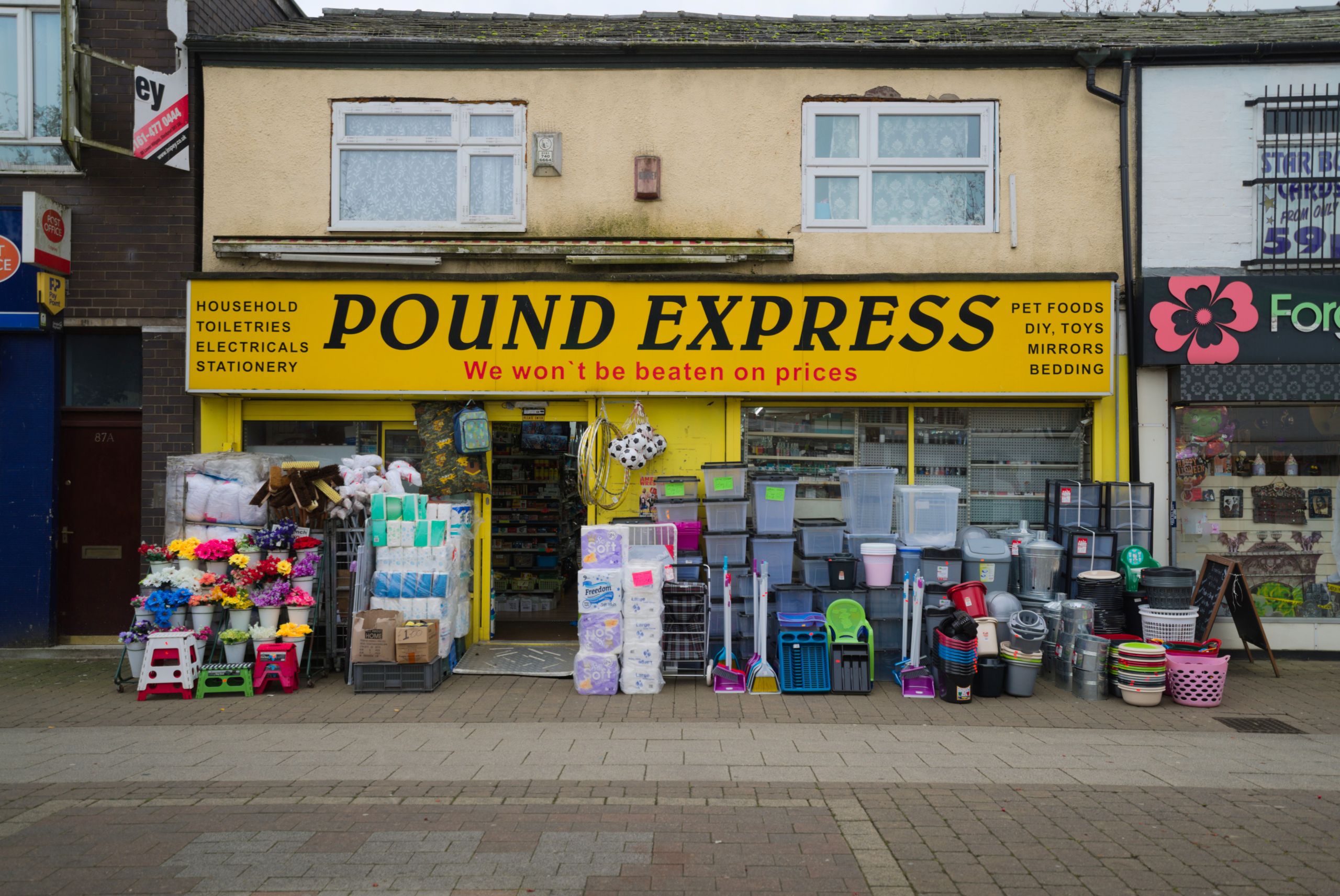Inclusive Growth in Greater Manchester 2020 and beyond
Taking Stock and Looking Forward

Executive summary
The Inclusive Growth Analysis Unit (IGAU) has taken stock of the progress that has been made in Greater Manchester (GM) towards inclusive growth, in the period since 2016 when inclusive growth started to become a prominent objective for UK cities. It has reviewed developments in policy and practice, principally those of the Mayor and GM Combined Authority (GMCA), but also of local authorities, businesses and organisations in the voluntary, community and social enterprise sector. In this legacy report, IGAU ask whether what has been done is sufficient and if not, what else could be done. The report learns from case studies from around the UK and abroad.
Inclusive growth and why we need it in GM
Inclusive growth is the idea that economic prosperity should create broad-based opportunities and have benefits to all. It challenges economic models which have produced large rises in income and wealth for some, while sustaining high levels of poverty and high levels of inequality. Since the global financial crisis, sustained economic inequalities, increasing social divisions and the rise of nationalism and populism have led to calls for different models of economic and social policy which will involve more people in economic opportunity and result in prosperity that is more widely shared.
Greater Manchester needs more inclusive growth
While the Greater Manchester economy as a whole performs relatively well compared to other UK cities outside London, it underperforms the UK economy as a whole and that of other leading European city regions, such as Munich, Helsinki and Barcelona. There are significant problems with low pay and insecure employment, with around 620,000 people in relative poverty, a majority in working households. More neighbourhoods are in the top fifth of the national indices of deprivation in 2019 than in 2015. The centre of the conurbation has seen the lion’s share of job growth since before the financial crisis, although not always benefiting local residents, while outer areas like Rochdale and Tameside continue to struggle on many economic indicators. Women, minority ethnic groups and disabled people tend to fare much worse in terms of jobs and pay than men, white, and non-disabled people.
Tackling these social and spatial inequalities would enable GM to make more use of the talents of a wider range of its people. Changing economic behaviours and labour market practices would spread the benefits of economic activity more widely, raising living standards and combatting poverty and injustice.
Greater Manchester is about to enter a new policy period with a Mayoral election in 2020 kicking off a new four-year Mayoral term and a refreshed GM strategy. The report makes recommendations about what could be done in this period to consolidate and extend the work started to date, and to set out on a more ambitious path towards a fairer economy and society in the future.
Inclusive growth policy and practice has two broad spheres of activity:
working towards economic structures and activities that are more inclusive by design, for example: fairer systems for profit-sharing and reward; more equitable employment practices; and better quality jobs.
making sure that local people are connected to economic opportunities, physically (in terms of housing, transport and digital connectivity) and in terms of having the education, training, health and care services they need.
Within these spheres, IGAU expect to see a particular emphasis on areas or groups of people more likely to have been excluded in the past.
Progress towards inclusive growth in GM
IGAU assessed progress in GM against a wide range of ideas and examples that are emerging as cities in the UK and internationally (and countries, including Scotland and Wales) experiment with policies to achieve inclusive growth. It looked at the two main spheres of inclusive growth policy – designing more inclusive economies and linking people to opportunities – and at policies to tackle social and spatial inequalities. IGAU also looked at how GM is approaching inclusive growth in terms of strategy, leadership, delivery and measurement. Table 1 summarises those findings.

Table 1. Progress on inclusive growth in GM. Summary of Adoption of Inclusive Growth in GM Local Authorities
Table 1. Progress on inclusive growth in GM. Summary of Adoption of Inclusive Growth in GM Local Authorities
Overall, these developments represent substantial progress. They will need to be sustained and built upon, and there will be new opportunities, such as bus franchising, which will need to be approached with an inclusive growth lens.
What has not yet happened in GM is the bringing together of these emerging policies in a clear vision and integrated approach. Inclusive growth still means different things to different people and is more prominent in some policy areas than others. This is in contrast to some other parts of the UK where inclusive growth is being adopted as the central objective of economic plans and/or it is becoming embedded into policy-making and investment decisions through the use of inclusive growth metrics, decision tools, and new funds. Nor is inclusive growth yet a long term vision, shared by the citizens of GM, which sets out goals, values and principles about the kind of growth GM wants, how it will be achieved, and how it will serve wider social and environmental objectives and ensure a successful inclusive transition into a low-carbon, high tech future.
Full report PDF available here
Summary of recommendations

In the next Mayoral Term (2020 -2024) the Mayor of Greater Manchester should signal a commitment to inclusive growth as the central motif of his/her Mayoral term. His/her central objective should be to set GM on a long term path towards a fairer and more sustainable economy and society. To support this the political leaders of GM should adopt a clear statement of what they mean by inclusive growth and the ways in which it will make a difference to GM citizens, including those on the lowest incomes. This should be the centrepiece of the new GM strategy (GMS). Stronger mechanisms should be established to ensure that inclusive growth outcomes are considered in all major policy decisions. GM should establish a successor organisation to IGAU to ensure that it has dedicated support for research, analysis and policy development on inclusive growth. It should work with central government and other cities to make clear the principal financial, policy and regulatory barriers to inclusive growth at subnational levels and how these can be addressed in future devolution settlements.
Between 2020 and 2024, the Mayor, Combined Authority (GMCA) and other GM leaders should take specific action to embed and develop inclusive growth strategies for the economy, places and people.
On the economy they should design and build a stronger and more integrated eco-system to support the development and continuation of inclusive economy activities. Meanwhile the Mayor and GMCA should commit to the development of the good employment charter, to publishing their plan for the foundational economy, to providing support and resources to develop the work on the development of the Co-operative Commission and start work on the development of mechanisms to protect quality of work and pay for workers in the ’gig’ economy. They should work with other combined authorities to review and report on opportunities and constraints in promoting good employment at city region level. The Mayor should establish an Inclusive Growth Investment Fund in order to support innovative proposals led by business, voluntary, community and social enterprise actors and to support scaling up.
On places, GMCA should develop inclusive economy plans for all major development sites identified in the Greater Manchester Spatial Framework and for the Town Centre Challenges. The Mayor should appoint a senior figure as a Neighbourhoods Champion who should have an overall objective to make sure all neighbourhoods of Greater Manchester benefit from the city’s economic, technological, environmental and social transformation, especially those which have previously been vulnerable to the forces of change. GMCA should develop ‘Total Place Plus’ pilot projects which will build on the Unified Public Services Model to incorporate shared planning and delivery in public services with place-based social economy and employment initiatives.
On people, the Mayor and GMCA should establish strategic oversight of the GM education and training system as a whole, whether or not additional formal powers are devolved. GMCA should develop inclusive education and training plans for growth sectors, supported by the proposed GMLIS investment pot. They should strengthen links between equality and diversity strategies and education/employment/skills strategies.
The Mayor should also take steps in the next mayoral term to set a more ambitious long term economic, social and environmental vision for GM. Following the examples in the report, he/she should commission deliberative work with residents in order to understand what they mean by ‘prosperity’, ‘inclusion’, ‘living standards’ and inclusive growth and what kind of GM people want. This should be the basis for the 2024 GM strategy.
Full report PDF available here

1. Introduction

‘Inclusive growth’ – a term relatively unfamiliar in the UK five years ago but now increasingly common – captures the idea that economic prosperity should create broad-based opportunities and have benefits to all. It challenges economic models which have produced large rises in income and wealth for some, while sustaining high levels of poverty (including for those who are working) and high levels of inequality.
Definitions of inclusive growth:
‘broad-based growth that enables the widest range of people and places to both contribute to and benefit from economic success’
‘growth that combines increased prosperity with greater equity; that creates opportunities for all & distributes the dividends of increased prosperity fairly’
'growth that is distributed fairly across society and creates opportunities for all'
Over three years ago in summer 2016, IGAU's report Inclusive Growth: Opportunities and Challenges for Greater Manchester reviewed evidence of inclusive growth in GM. IGAU set out the evidence that, despite recent economic success, GM still fell a long way short of its 2020 vision to pioneer “a new model for sustainable economic growth based around a more connected, talented and greener city region where all our residents are able to contribute to and benefit from sustained prosperity and enjoy a good quality of life”. IGAU argued that, like other large ex-industrial cities, GM faced considerable challenges in achieving this vision: persistent poverty; a changing economic geography with growth concentrated in central areas; changes in labour market structure with increasing concerns about low pay, underemployment and precarious work; and large disparities in economic opportunity and outcomes between people from different social and ethnic groups. Drawing on a local consultation and emerging evidence of what inclusive growth policies might look like, we followed up with a second report: Achieving Inclusive Growth in Greater Manchester: What can be done?
A great deal has happened in GM since then: the election of a Mayor; the adoption of new Greater Manchester Strategy; publication of a revised spatial framework setting out a long-term plan for the city region; an Independent Prosperity Review (GMIPR) and a new GM local industrial strategy. Once implicit, inclusive growth has increasingly become a more explicit aim of GM strategies and policies. At the same time, wider interest in inclusive growth has grown. In the UK, a high profile RSA Commission reported in 2017; an all-party parliamentary group has continued to meet; and a new think tank (the Centre for Progressive Policy) has been established to promote the agenda. Outside the UK, the Organisation for Economic Cooperation and Development’s (OECD) campaign for inclusive growth in cities and its ‘champion mayors’ initiative’ has gathered pace.
As the next GM Mayoral elections approach, the aim of this report is to take stock of the progress that has been made since 2016/17 and, crucially, to consider what might be done next. Are the challenges still the same? What policies have been put in place, and are they sufficient? Is GM ‘on track’ for more inclusive growth or do efforts need to be ramped up? If more could be done, what should it be? What can be learned from the emerging national and international evidence on inclusive growth and from promising examples in other cities?
The report is structured as follows. In Chapter 2, IGAU briefly review statistical evidence on the GM economy, poverty and social and spatial inequalities. This, as IGAU sees it, is the challenge for inclusive growth. Chapter 3 explains more about what inclusive growth means and might look like in practice. IGAU also consider some other current terms and ideas related to inclusive growth and overlapping in some ways, since many of the ideas and examples it looks at could also be described in these terms – ‘economic justice’ or ‘community wealth building’ for example.
Chapters 4 to 7 review different aspects of inclusive growth policy in GM. In each, we describe and assess policy developments, in the light of emerging understandings of what inclusive growth policies might look like – drawn from a growing inclusive growth literature and knowledge base. IGAU also provide short case study examples from other places around the UK and abroad which suggest ways in which GM policies might develop. The methodology for gathering and reviewing this evidence is covered in Appendix 1. Chapter 4 covers the take up of inclusive growth ideas in GM as a whole and looks at issues of strategy, leadership, delivery and measurement. Chapters 5 and 6 cover the two principle spheres of inclusive growth activity: designing more inclusive economies and including more people in the opportunities that are created. Chapters 7 and 8 cover spatial and social inequalities and the ways in which policies are responding to these. IGAU arrive at an overall view in Chapter 9, and make a set of recommendations for taking the ‘inclusive growth agenda’ forward in GM in the next policy period.
The report will obviously be of most interest to people in GM itself. But as many city regions and other places also attempt to get to grips with inclusive growth, we hope it will be a useful reference point and guide for others in the UK and beyond.
Full report PDF available here
2. Greater Manchester in 2019:
The Challenge for Inclusive Growth

To set the scene for the report, IGAU took a brief look at the challenges to inclusive growth in Greater Manchester, starting with an overview of the economy. As is widely recognised, the GM economy as a whole performs relatively well compared to other UK cities outside London in terms of economic growth. In 2017 (latest available figures), GM was the third largest city region economy outside London, with total GVA of £66.4 billion. This compares to £66.7bn for West of England combined authority and £69.6bn for Leeds City Region. Of the seven English core city regions outside London, GM ranked third highest in terms of GVA per filled job, with a figure of £48,1848. Figure 1 shows that, both in nominal terms and when controlling for inflation, the GM economy performed slightly better than the city region average over this period.
However, GM continues to lag behind the UK average on measures of productivity. Since 1991, it has accounted for only around 90% of the UK average on GVA per head. Just as the UK tends to underperform other comparable economies on measures of productivity, GM’s productivity is also behind that of many leading European city-regions, such as Munich, Helsinki and Barcelona, as well as Naples, Stuttgart, Cologne, and Utrecht.
Thus, on conventional measures it would appear both that GM has a relatively successful economy, within which it wants to ensure more widely shared opportunity, and that there is room to unlock further economic potential through drawing more effectively on the talents and efforts of a greater number of citizens. In the remainder of this chapter we consider some of the challenges to these ambitions.
GM’s industrial legacy
Though GM has, on the whole, successfully transitioned to a modern knowledge economy, the city region is still dealing with the legacy of its industrial past, and the rapid de-industrialisation that has followed. This transition entailed large scale job losses which had long-term economic and social consequences for individuals, their families and local communities.
One prominent manifestation of this is high levels of ill health, especially for older people. Life expectancy at birth for both male and female newborns in 2015-17 was almost two years lower in GM than for England as a whole, at 77.8 and 81.3 respectively. This figure is substantially lower in some parts of GM, with life expectancy at birth for males (2013-17) as low as 69.9 years in parts of Oldham, compared with 84.9 in parts of Stockport – a gap of 15 years. For older men, life expectancy at age 65 is 17.6 years in GM compared to 18.8 for England. GM lags behind the UK on almost all measures of public health. For example, around two-thirds of adults are overweight or obese, and one in five adults smokes. Across almost all standard published measures of alcohol harm, GM local authorities (LAs) fare significantly worse than average. In 2016, Manchester LA had the highest rate of preventable mortality in the UK, almost two and a half times higher than the area with the lowest rate. Correspondingly, more people are providing unpaid care in GM: for example, 26 people per 1000 of working age are in receipt of carers allowance compared to 21 for England overall.
Low levels of skills in the adult population also bear witness to a history of industrial employment and low employment opportunities in the post-industrial era. Around one fifth (20.6%) of working age people in GM (365,600 in total) have either no or low qualifications, compared to 18.2% for England overall, and this is higher (over 24%) in some older industrial areas Bolton, Oldham, and Rochdale. Having no or low qualifications is particularly prevalent among older working age residents (28.2% for 50-64 year olds), with a larger gap to the national figure (7.1 percentage points compared with 1.8 for 16-24 year olds). However, while educational attainment is higher among younger generations, the spatial pattern of attainment remains remarkably similar to that of earlier decades. At secondary school, the average ‘Attainment 8’ score of young people in GM was 45.4 points in 2017/18 – 1.2 points lower than England overall at 46.6 points – and lowest in Salford and Oldham (41.0 and 42.7 points, respectively). These LAs, alongside Rochdale, Tameside and Bury, have been identified as social mobility ‘coldspots’.
Changes in the economy and labour market
The figures in the previous section serve as a reminder that there is a continuing need for social investment in health, adult learning and retraining to support the development of ‘human capital’ across GM. But there are also wider changes underway in the GM economy, which are affecting the kinds of jobs that are available and the risks and rewards that workers face in different sectors. While these changes are not unique to GM they are making life more difficult in particular places and for people who are employed in less secure and poorly-paid sectors and roles.
Over recent decades, GM has broadly followed England in terms of labour market polarisation with faster growth in both professional, managerial and technical jobs, and operative and elementary jobs than ‘middle level’ and service jobs. Toward the top end of the labour market, these trends play out in rising earnings at the top and middle of the distribution – though this has come alongside rising house prices (and rental costs).
Low pay is a significant issue in GM. Median hourly pay for residents is 9% lower than the UK average, and in 2017 residents were paid over £1500 less in real terms per year than in 2008. In 2018, around 24% of employee jobs in GM were paid at or below the Living Wage (a fall since the previous year and slightly fewer than in England as a whole). Rates of underemployment have fallen since the recession, but remain higher than in 2007 at just under 6% in 2017, around one percentage point higher than in the UK (excluding GM). Job security is also an issue, with only 10% of all jobs created between 2007 and 2016 being full time positions. One in five of the GM labour force (21%) is either self-employed, employed on a temporary basis, or on a zero hours contract (ZHC), and in 2017 it was estimated that there were around 30,000 workers on ZHCs.
There has also been a marked spatial pattern to economic growth in GM. Nationally, economic growth based around finance, professional services and knowledge industries has largely benefited urban cores, fuelled by investment in an ‘urban renaissance’, while job growth and output growth in many former industrial towns has been sluggish. This spatial pattern is evident in GM’s growth story, with Manchester itself generating most of GM’s GVA growth since 2000 (Figure 2), due principally to growth in job numbers rather than productivity increases. Manchester also accounted for 54% of the growth in GM jobs in the period since the onset of the financial crisis. Together, Manchester, Trafford and Salford accounted for 75% of all new jobs created in GM across the ten years since 2007. In contrast, two GM LAs (Tameside and Rochdale) saw job numbers decline in this period.
The extent to which GM residents can take advantage of these patterns of job growth depends partly on skill levels and other supply-side factors including health, and also the availability and cost of transport relative to wages. GMCA’s analysis of commuting to the regional centre suggests that a large majority of workers travel in from South Manchester, Stockport and Trafford, with far fewer coming from the Northern LAs, particularly Bolton and Wigan. Competition from longer-range commuters is also an issue – 21% of workers in the regional centre commute from outside GM, with many coming from south of GM in Cheshire and High Peak, as well as Calderdale and Chorley. Manchester LA has the largest gap between weekly workplace and weekly resident wages of all core city LAs, at £63, both because workplace wages are relatively high in Manchester (third highest at £556 per week in 2018) and because resident wages are low (second lowest at £493 per week).
Spatial and social inequalities
These trends and others, not least policies of ‘austerity’, have produced a situation in which the benefits of economic growth are not currently being felt in all parts of GM and among all population groups. According to the most recent estimates, there are around 620,000 people living in relative poverty in GM, of which 61% are of working age. 3 in 5 working-age households in poverty in GM include someone who is in work. Three of GM's ten LAs (Manchester, Salford and Rochdale) are in the top decile of all LAs in Great Britain (GB) in terms of destitution rates, with Manchester being the only LA in GB in the top decile on all three types of destitution (complex needs, migrant destitution, and UK-other).
The most recent release of the Index of Multiple Deprivation (IMD) shows an increase in the proportion of GM neighbourhoods (small statistical areas known as LSOAs) among the top 10% and 20% most deprived areas in England. 23% of GM neighbourhoods were among the 10% most deprived in 2019 compared to 21% in 2015, and 38% were among the 20% most deprived in 2019 compared to 35% in 2015. This reverses a trend of improvement evident in successive releases of this data since 2004. The trends partly reveal an ‘inner- outer’ issue. Manchester, Salford and Trafford are the only LAs with a smaller proportion of LSOAs in the most deprived 10% than in the IMD2004, and of the 42 extra GM LSOAs that are now in England’s most deprived decile, 26% (11 areas) are in Oldham.
IGAU’s research also shows that between 2001 and 2013, areas of severe income deprivation within the outer ring road (i.e. the M60 motorway around GM) tended to decrease in size and on rates of income deprivation, while similarly deprived areas beyond this boundary were more likely to have stayed the same or grown in size, while experiencing an increase in income deprivation rate. But this is not the whole picture. It remains the case that the majority of GM’s poorest neighbourhoods are in inner areas of North and East Manchester and Salford, in relatively close proximity to economic opportunities in the centre of GM. Many of these areas have seen reductions in deprivation rates, but in some cases this is due to more affluent people moving in rather than to decreases in the number of people in poverty. In fact, the number of people in poverty increased in the regional centre between 2001 and 2013.
Economic disparities between social groups are also large and persistent in GM. 2016 figures show that all Black and Minority Ethnic (BME) groups in GM were less likely to be employed than White people. Some appear to be particularly affected by low pay. According to the GMCA, 33% of Black employees in GM are low paid, compared to 22% in Birmingham and 21% across GB.
People from BME groups are also less involved in apprenticeships. The apprenticeship ‘ethnicity gap’ for BME groups overall was 5.8 percentage points in 2015/16 meaning that whilst 16.2% of GM residents were from BME groups, they only accounted for 10.4% of all apprenticeships. They were also under-represented in higher level apprenticeships.
Employment rate gaps between disabled and non-disabled people are narrowing slightly but still large and higher in GM than for the country as a whole (in 2019, 37.5 percentage points in GM compared to 33.8 in England). There also remain marked gender disparities in the labour market with men over-represented in higher-paid occupations, making up two thirds of managers, directors and senior officials while women are over-represented in roles which often attract lower pay, including caring, leisure and other service occupations. These differences manifest in the gender pay gap. While, at first glance, GM fares well on this measure, this is only because men in GM are paid poorly compared to the national average, rather than being due to women receiving relatively better pay (men in GM are 10% below the average for England, compared to 5% for women).
The future
These data indicate the scale of the challenge of inclusive growth in GM, and the need to approach it as a long term agenda not a quick policy fix. Forward projections for some of these measures indicate that some of these challenges may deepen in coming years. For example, employment forecasts suggest that Rochdale and Tameside, as well as Oldham and Wigan, are set to experience falling employment over the period to 2038; whereas jobs are forecast to grow in central and southern areas of the city region.
Since we last reported, however, it has become increasingly obvious that inclusive growth must not only be seen as a response to current inequalities and their origins in contemporary economic organisation and labour market structures, but as a way to navigate the challenges of environmental, technological and demographic change, some of which are already firmly upon us. The situation described in this chapter is in many ways the product of a failure to fairly manage the transition from an industrial to a post-industrial economy. Finding a way to achieve inclusive growth whilst addressing the challenges posed by economic and environmental change is the urgent task that national and local policy makers now face.
This challenge requires work that is well beyond the scope of the report: forecasting implications for GM; working out what action is needed, and perhaps even developing the concept of inclusive growth itself, so that it is fit for a broader purpose. Our contribution here begins to signal some of the links and future directions but much more will need to be done.
Full report PDF available here
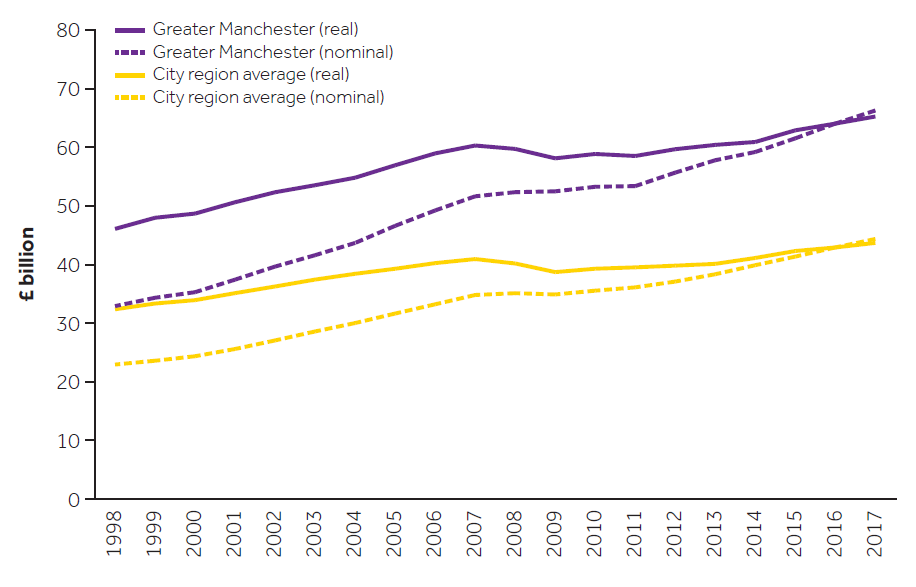
Figure 1: Trends in Gross
Value Added (GVA), GM
compared with city region
average
. Source: ONS (2018). Regional gross
value added (balanced) by combined
authority, city regions and other
economic and enterprise regions of
the UK.
Figure 1: Trends in Gross Value Added (GVA), GM compared with city region average . Source: ONS (2018). Regional gross value added (balanced) by combined authority, city regions and other economic and enterprise regions of the UK.
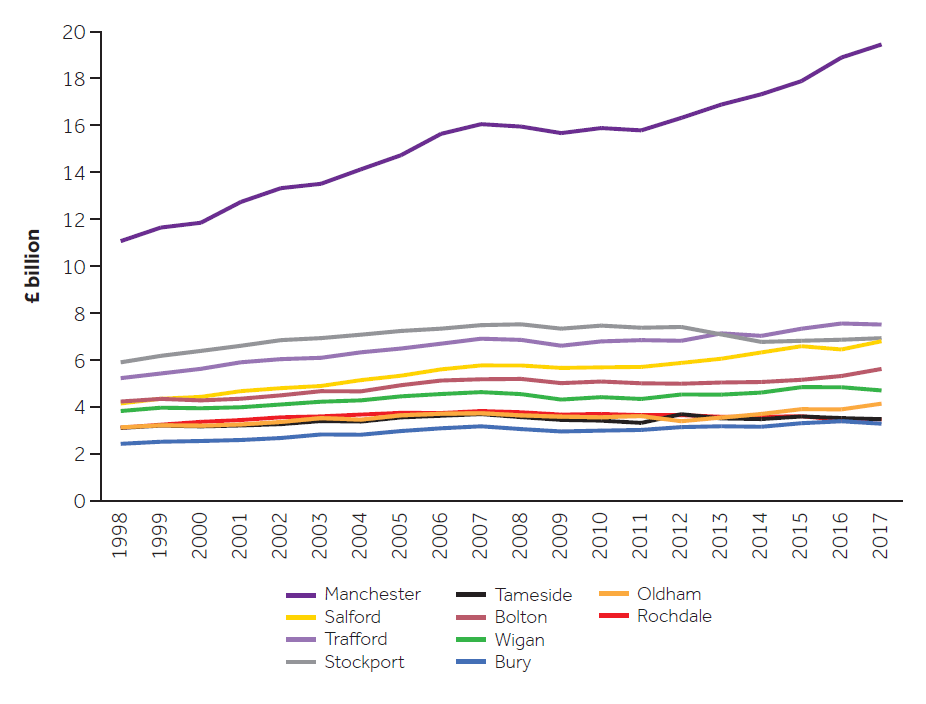
Figure 2: Trends in real Gross Value Added (GVA) for GM local authorities, 1998-2017. Source: ONS (2018). Regional gross value added (balanced) local authorities (UKC North West 1998- 2017)..
Figure 2: Trends in real Gross Value Added (GVA) for GM local authorities, 1998-2017. Source: ONS (2018). Regional gross value added (balanced) local authorities (UKC North West 1998- 2017)..
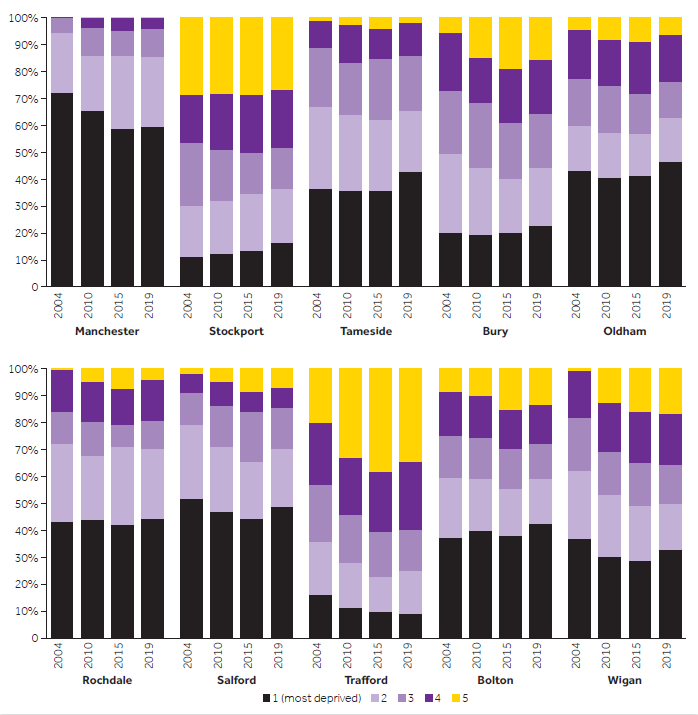
Figure 3: Proportions of neighbourhoods in each quintile group of the Index of Multiple Deprivation, 2004, 2010,
2015 and 2019.
Figure 3: Proportions of neighbourhoods in each quintile group of the Index of Multiple Deprivation, 2004, 2010,
2015 and 2019.
3. Inclusive growth
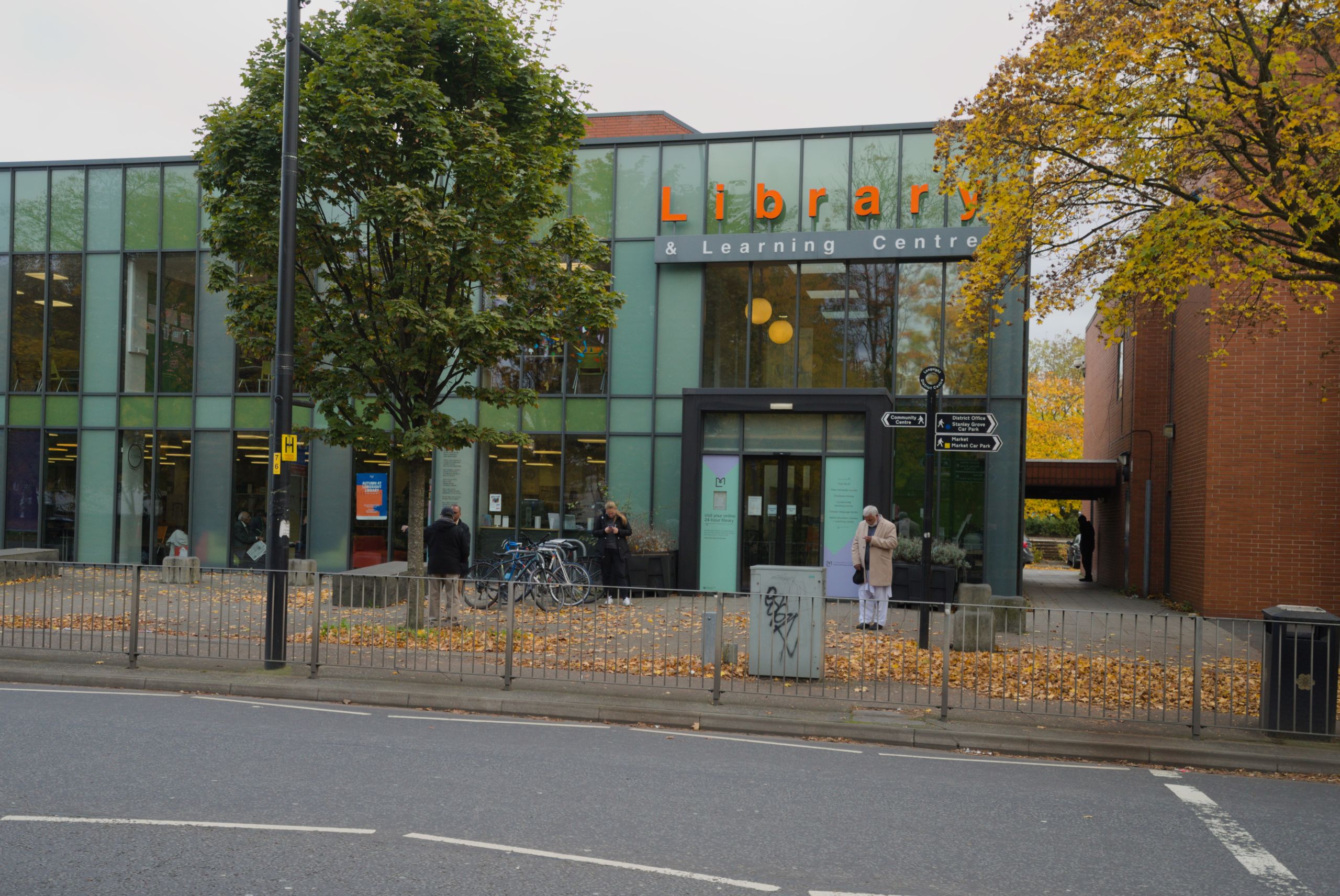
Key points:
■ Inclusive growth is economic growth that creates broad-based opportunities and benefits for all.
■ Inclusive growth policy and practice includes working towards economic structures and activities that are more inclusive by design as well as making sure local people are connected to economic opportunities.
■ It often focuses on reducing spatial inequalities and improving outcomes for marginalised and disadvantaged groups. Not everyone prefers ‘inclusive growth’ as an objective. Other ideas and agendas are also concerned with building fairer economies, such as ‘economic justice’ and ‘community wealth building’. But there are often overlaps in the practical policies and strategies that are linked to these terms.
What is inclusive growth?
Inclusive growth is usually understood as economic growth that creates broad-based opportunities and benefits for all. It is presented as an alternative to models of growth which have increased the aggregate income and wealth of nations, regions or cities, but left many people and places behind.
While interpretations of inclusive growth and emphases differ, the key concepts are generally agreed:
■ a concern to address inequalities, poverty and exclusion, relating to people and/or places.
■ a recognition that inclusion benefits the economy, as well as being an end in itself. Enabling more people to participate fully and fairly in economic activity is the basis for more prosperous and sustainable economies. Investment in people, services and communities should therefore be seen as an economic strategy, not a drag on the economy, and firms should expect to benefit from more inclusive employment practices.
■ a focus on the nature of the economy and labour market in producing inclusion or exclusion, not a ‘grow now, redistribute later’ model which relies on taxes, benefits and public services to correct economic inequalities. Economic activity should be organised in ways which deliver better and more widely shared social outcomes.
What inclusive growth looks like in practice
Inclusive growth policy and practice has two broad spheres of activity. One is working towards economic structures and activities that are more inclusive by design for example: fairer systems for profit sharing and reward; more equitable employment practices; better quality jobs that provide decent wages, dignity and value and opportunities to train and progress, and which support health, wellbeing and family and community life. At a local level this can include encouraging and supporting particular sectors or types of organisation, including those owned by employees, as well as influencing and supporting the behaviour of existing employers. Business finance, business support, employer pledges, and local collaborations to help employers pool functions and expertise are some of the tools that areas can draw on.
The other sphere of activity is making sure that local people are connected to economic opportunities. This involves attention to physical infrastructure – business location, affordable housing, transport connections and digital connectivity. It also involves social infrastructure such as: investment in education and training, healthcare provision and public health promotion; child and elder care; and community services.
Because inclusive growth is a response to spatial and social inequalities, either or both these spheres may have a particular emphasis on areas or groups of people more likely to have been marginalised in the past. Where there is an emphasis on spatial inclusion, policy tools may include infrastructure investment, the use of planning powers, local procurement strategies, and spatial targeting of the ‘inclusive economy’ initiatives mentioned above. Where there is a concern about social inequalities, inclusive growth strategies could be expected to include stronger focus on equal opportunities in education and the labour market and specific initiatives to support under-served groups, for example minority ethnic small and medium sized enterprises. In practice the emphasis that is placed on these kinds of activity varies depending on how inclusive growth is interpreted and located within governments. In Scotland and Wales, inclusive growth is an integral objective of economic strategies. Key policies include: fair work pledges linked to business support and funding; Living Wage commitments in care sectors; employment and skills initiatives; infrastructure investments; regional economic development plans; programmes to reduce educational inequalities; improvements in childcare availability and affordability; and (in Wales) a focus on skills development, new business models and infrastructure in ‘foundational sectors’ (see Box 2). A recent report on inclusive growth in Scotland revealed high level strategic commitment and the emergence of inclusive growth as an organising principle across government but also considerable confusion about how to translate it into practice in different policy areas. There was insufficient understanding of which people and which places are currently excluded from the benefits of growth, and how policies would benefit them.
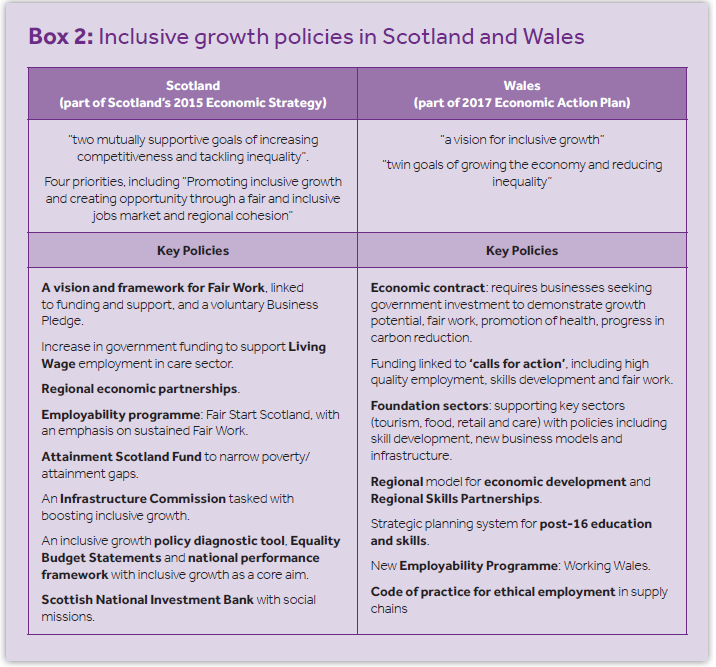
Box 2 Inclusive growth policies in Scotland and Wales. Sources: Scottish Government (2015). Scotland’s Economic Strategy; Welsh Government (2017). Prosperity for All: Economic action plan.
Box 2 Inclusive growth policies in Scotland and Wales. Sources: Scottish Government (2015). Scotland’s Economic Strategy; Welsh Government (2017). Prosperity for All: Economic action plan.
In England, policies on gender pay and pay ratio reporting, the establishment of the Race Disparity Unit and audit, the announcement in 2019 of an Office for Tackling Injustices, corporate governance reform measures, and the focus on place in industrial strategy, are consistent with the goal of ‘an economy that works for everyone’, but inclusive growth has not been adopted as economic policy. An Inclusive Economy Unit based in the Office for Civil Society in the Department for Digital, Culture, Media and Sport (DCMS) focuses on the particular issue of working with businesses and investors to generate social investment and impact, rather than on more fundamental approaches to economic reorganisation such as the ownership of production, finance and taxation, and employment regulation. An All Party Parliamentary Group (APPG) on Inclusive Growth was also established in 2014, committed to “finding a new model of inclusive growth that better benefits the majority and reconnects wealth creation with social justice”. Priorities in 2019 have included developing inclusive growth metrics and considering the impacts of automation and the future of work.
Inclusive growth is also understood differently across the English combined authorities, and this understanding is evolving over time. The North of Tyne’s devolution deal with central government had a limited definition of inclusive growth, framed in terms of employment support (including in work progression), school improvement, and adult education and skills including attraction and retention of graduates and skilled workers. In the West Midlands, which like GM was one of the pilot areas for local industrial strategies, inclusive growth is now positioned as part of an ‘inclusive, clean, and resilient economy’. Priority issues include low pay sectors, inwork progression, ethnic diversity, promoting women into sectors in which they are under-represented, youth employment, social enterprise, commissioning and procurement, vulnerability and bespoke solutions for individuals.
Thus, it is clear that while there are some broad principles and some common policy approaches encapsulated by the term ‘inclusive growth’, there is not a common understanding nor a blueprint for action. Understanding and plans are at different stages of development, and different issues are prioritised in different places.
Other ideas connected to inclusive growth
It is also important to recognise that inclusive growth is also not the only formulation of the need for a fairer economy and society that has gained (or regained) popularity in the wake of the global financial crisis. Other ideas have traction and support.
These include ‘economic justice’, ‘community wealth building’, ‘inclusive economy’, ‘shared prosperity’ and ‘social value’. Within and alongside these, there are others who emphasise the need to re-focus on the ‘foundational economy’, or who emphasise spatial rebalancing of the economy or ideas of ‘territorial justice’ (see Box 3). These ideas have different origins and are associated with different political ideologies. Some are arguably more radical in ambition than most versions of inclusive growth. Some make explicit critiques of inclusive growth: that in its emphasis on growth it is tinkering at the edges of a failed capitalist system; that its economic emphasis is too narrow to deliver social justice; that it fails to recognise the much more fundamental challenges of sustainability; that it could be seen to be dependent on growth, giving insufficient attention to economic inclusion in the existing economy; and that it is too much focused on remedying past problems than preparing for future challenges. As we show in Chapter 4, some of these ideas are underpinned by different notions of inclusion, growth, prosperity or well-being, with different measures and differently weighted priorities. But there are also some common ideas underlying these terms and much overlap in the practical policies and strategies that are implied.
The approach of the report
The main aim of this report is not to debate or contest the various terms related to inclusive growth, or indeed to defend ‘inclusive growth’ as the right term. As IGAU report, within GM, there are political differences over these terms and agendas. Some policies and practices which might be labelled as ‘inclusive growth’ in one place (such as local procurement) might be motivated in others by a commitment to ‘community wealth building’. The main objective is to document what is happening. In doing so, IGAU hopes to prompt further debate about whether inclusive growth is the right term for GM’s activities or the right ambition, and offer some helpful substance to that debate, but the ideological debate in itself is not the objective of this work.
The report is also not an evaluation of whether policies have worked. Such an evaluation should be done, but our view is that it is mostly too early to do it, partly because inclusive growth has very long term objectives (challenging decades of high inequality) and partly because it is a developing agenda. It would be unrealistic to expect that policies introduced since 2016 would have had time to make a significant difference on the ground. Even if they had, few have been evaluated in ways which make a robust assessment possible. Thus, although IGAU draw on evaluation evidence where it exists, this is not its primary ambition or approach. Instead IGAU ask three broad questions about GM’s policy direction, the extent of progress, and the possibilities for further action:
■ In what ways and to what extent do high level policy statements in GM reflect intentions towards inclusive growth?
■ What policies are actually being pursued and how do these compare with broader understandings of the suite of policies that are understood to promote inclusive growth?
■ What evidence or examples from within or beyond GM suggest promising ways in which policy might develop in the future?
IGAU divide the evidence according to the main spheres and dimensions of inclusive growth identified at the start of this chapter: developing more inclusive economies, connecting people to economic opportunities, tackling spatial inequalities, and addressing inequalities between groups. Appendix 1 describes our methodology for reaching our assessment.
Full report PDF available here
Box 3
Some other key ideas linked to 'inclusive growth'
Inclusive economy: a term often preferred by critics who argue that inclusive growth is too growth-dependent or that it offers insufficient challenge to market-liberal policies that produce inequalities.
Community/local wealth building: ‘inclusive economy’ policies that focus on restructuring production and democratising ownership and control so that more economic activity has direct benefits to local residents.
Economic justice: the broad idea that economic activity should be fair – including the labour market and wage bargaining, ownership of assets and wealth, governance of firms, and financial systems.
Territorial justice: the idea (in social policy) that people should have equal access to public services wherever they live. Linked to inclusive economy ideas, may also refer to territorial ‘rebalancing’ of the economy to ensure greater spatial equality of economic opportunities and benefits.
Social value: the idea that economic actors should maximise the positive social, economic and environmental outcomes of their activity. A term increasingly used since the 2012 Social Value Act which requires public authorities to have regard to these issues.
Foundational economy: Focuses on the large portion of the economy concerned with the provision of essentials, including utilities and financial services as well as education, health and care.
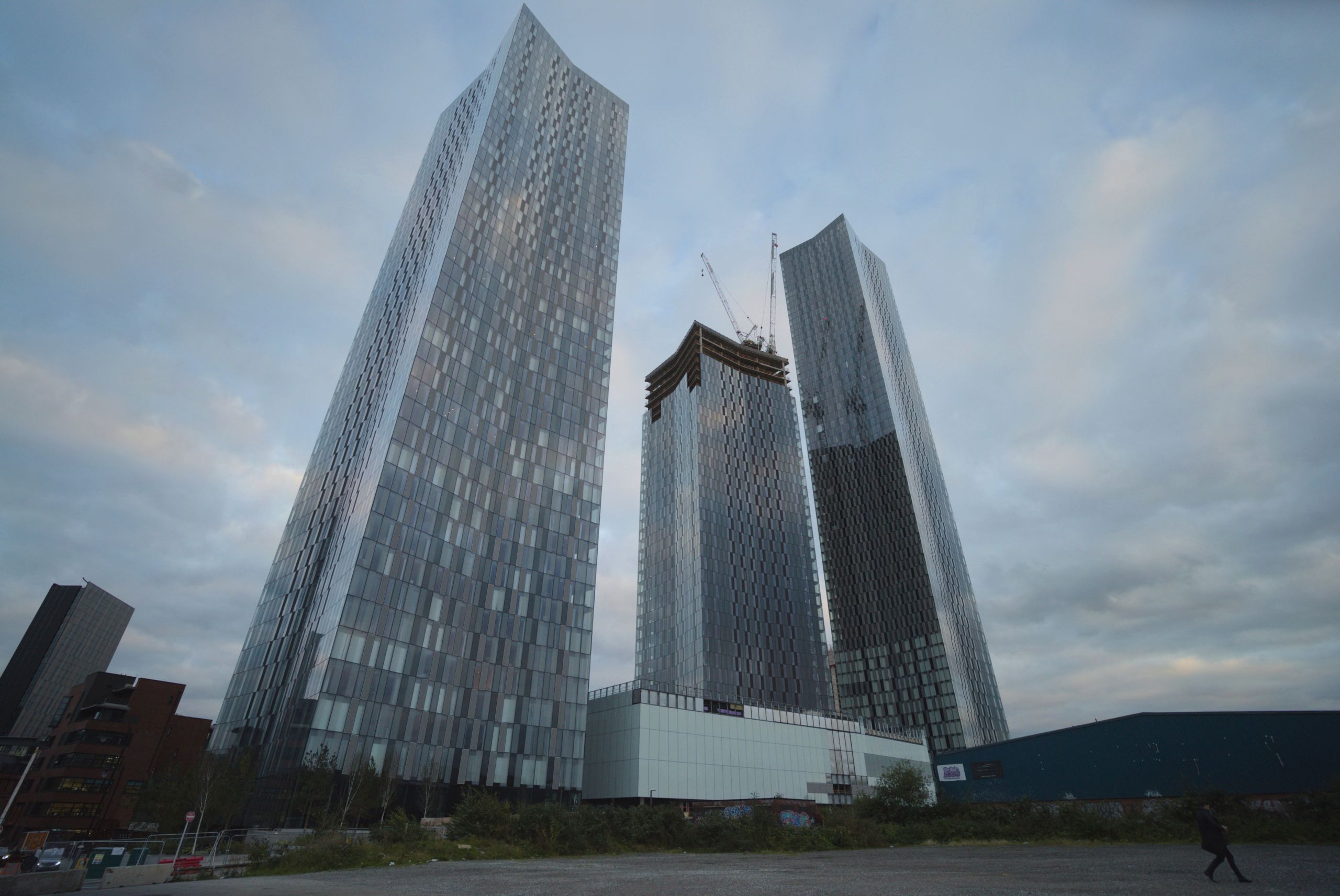
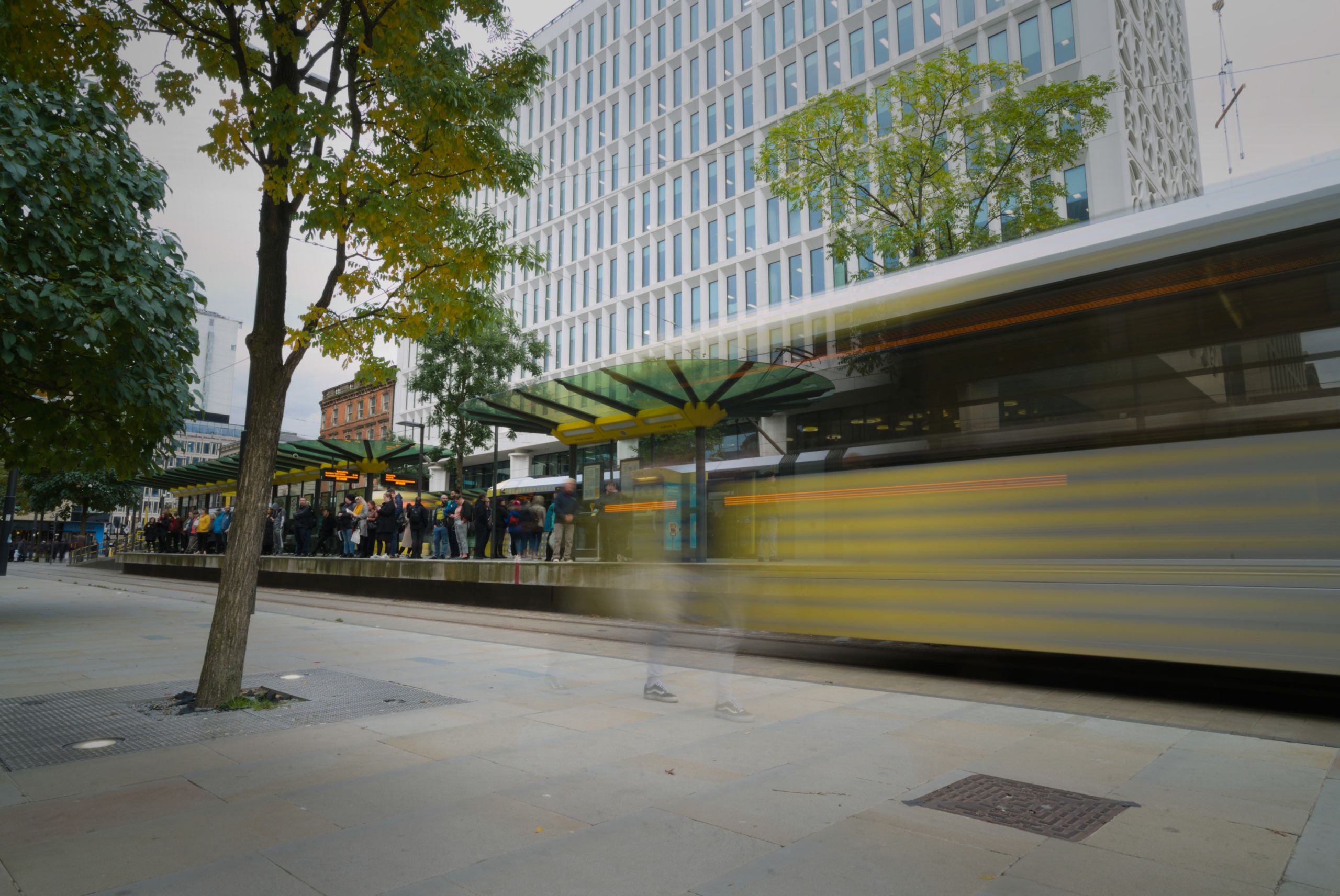
Box 3: Some other key ideas linked to 'inclusive growth'
Inclusive economy: a term often preferred by critics who argue that inclusive growth is too growth-dependent or that it offers insufficient challenge to market-liberal policies that produce inequalities.
Community/local wealth building: ‘inclusive economy’ policies that focus on restructuring production and democratising ownership and control so that more economic activity has direct benefits to local residents.
Economic justice: the broad idea that economic activity should be fair – including the labour market and wage bargaining, ownership of assets and wealth, governance of firms, and financial systems.

Territorial justice: the idea (in social policy) that people should have equal access to public services wherever they live. Linked to inclusive economy ideas, may also refer to territorial ‘rebalancing’ of the economy to ensure greater spatial equality of economic opportunities and benefits.
Social value: the idea that economic actors should maximise the positive social, economic and environmental outcomes of their activity. A term increasingly used since the 2012 Social Value Act which requires public authorities to have regard to these issues.
Foundational economy: Focuses on the large portion of the economy concerned with the provision of essentials, including utilities and financial services as well as education, health and care.

4. Strategy, leadership, delivery and measurement

Key points:
■ Emerging work on inclusive growth suggests that cities need to take systemic approaches, making
inclusive growth a ‘mission’ shared and delivered by multiple organisations. New metrics are needed,
measuring inclusion as well as growth.
■ There are clear political commitments to inclusive growth in GM and these have strengthened in
recent years. Approaches to governance in general have also broadened, with more people and
organisations having a say in GM strategy.
■ However, there is no clearly articulated definition of inclusive growth at the GM level and the term
means different things to different people.
■ GM has not yet established any central resource or tools to support and embed inclusive growth
across policy areas.
■ Examples from other places in the UK and abroad point to ways in which organisations can embed
inclusive growth thinking into policy development and appraisal, how they can broaden the leadership
of inclusive growth and how they can engage in longer term visioning processes involving citizens in
determining the inclusive growth outcomes they want to see.
Making inclusive growth happen
If one thing is agreed about inclusive growth, it is that it is a multi-faceted and long term agenda – not a single policy but an approach. In particular, inclusive growth brings an integration of social with economic policy spheres and so cuts across established administrative arrangements and responsibilities and requires the collaboration of multiple organisations in the private and third sectors as well as public administrations.
For this reason, considerable attention has been given to how cities can initiate, implement and sustain an inclusive growth approach. In the UK, this work has been led by the RSA Commission on Inclusive Growth and subsequently followed up by the RSA50 and by the Centre for Progressive Policy in a series of articles on ‘how to do inclusive growth’. Leadership strategies for inclusive growth also emerge in international research and from the OECD Champion Mayors for Inclusive Growth Initiative. Box 4 sets out some of the key ideas.
Work in this area is typically suggestive of what could be done, supported by innovative examples, rather than based on evaluation of what has ‘worked’. It is recognised that different economic, political and institutional contexts will shape how inclusive growth is led in any given place.
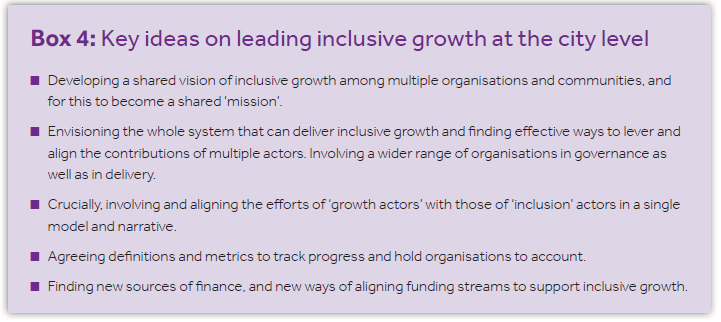
Box 4: Key ideas on leading inclusive growth at the city level
Box 4: Key ideas on leading inclusive growth at the city level
Inclusive growth as a strategic principle or ‘shared mission’ in GM
Inclusive growth as a principle has been recognisable in Greater Manchester and LA strategies for a long time, including in the 2013 GM strategy (GMS) which we cite in the introduction to this report. But how this vision of inclusive growth has been articulated and what it means for actual policies and practice has changed considerably in recent years.
Although it expressed the desire for everyone to contribute to and benefit from economic growth, the 2013 strategy had a clear economic/social divide. The growth strategy focused on the regional centre and other key growth sites and sectors, a market-led investment strategy and business support targeted on firms with greatest growth potential. Separately, ‘reform’ strategies (around early years, troubled families, justice, health and social care and worklessness and skills) were developed to re-design public services to build independence and self-reliance, and to reduce demand for (and cost of) public services, making GM a net contributor to the public finances.
By contrast, the GMS of 2017 was a substantially different document. Entitled ‘Our People, Our Place’ it was billed as a document for everyone in Greater Manchester, in which change would be driven “by our communities themselves… harnessing the strengths of Greater Manchester’s people and places [to] create a more inclusive and productive city region where everyone, and every place, can succeed”. “A thriving and productive economy in all parts of Greater Manchester” was only one of ten priorities covering all aspects of urban life from the early years to ageing, and the economy to the environment (Box 5).
Although the strategy did not mention inclusive growth specifically, politicians and officers often make reference to inclusive growth being “at the heart of the GMS” and the new GMS marking a move away from assumptions of social and spatial ‘trickle down’ that critics associated with previous versions of the strategy. Moreover, in launching GMIPR – an economic review designed to shape the GM local industrial strategy (GMLIS) – in May 2019, both Mayor Andy Burnham and Deputy Mayor Sir Richard Leese argued that inclusive growth was their central objective for the GMLIS. In this sense, inclusive growth could be seen as a strategic principle and a shared mission in GM. Again, however, the GMLIS document itself mentions inclusive growth only infrequently (9 times). By contrast, work towards London’s local industrial strategy (LIS) states in its first sentence (p. 2) that “the aim of London’s Local Industrial Strategy is inclusive growth – ensuring all of London’s places, people and communities can contribute to and benefit from the city’s growth, both today and in the future. As such inclusive growth also requires growth to be sustainable”.
The decision not to use the term ‘inclusive growth’ explicitly in GM leaves a situation in which it has different meanings in different articulations of GM strategy. As we describe in Chapter 7, inclusive growth is a prominent objective in the GM Spatial Framework (GMSF), referring to plans to ‘spread prosperity more widely’ by providing high quality investment opportunities across Greater Manchester. However, in the GMLIS, six of the nine mentions refer to investment in infrastructure for ‘digitally-driven, clean and inclusive growth’, while two are general aspirations and one relates to a business support programme. Nowhere in GM strategic documents is it yet set out what inclusive growth means and what policies and actions will follow from it.
Below the GM level too, interest in inclusive growth is expressed in different ways. Our consultation with GM LAs indicates that only one (Manchester, with Salford currently developing one) has an inclusive growth strategy per se, but almost all identify inclusive growth ambitions in other strategies including economic strategies, anti-poverty strategies. work and skills strategies and overall corporate plans. There are differences in positioning and action. In Manchester, Oldham and Salford, there is an emphasis on ‘inclusive economy’. Principles of community wealth building feature strongly in Oldham. Trafford’s approach has more emphasis on growth and connecting people to opportunity. In Wigan inclusive growth has become a key element in the ‘Wigan Deal’, which is reconfiguring relationships between residents, businesses, the Voluntary, Community and Social Enterprise (VCSE) sector and the local authority (LA) to work collectively towards a better borough.
Inclusive growth is also differently interpreted by other organisations within GM. A VCSE leadership group established in response to devolution has established an inclusive economy (not inclusive growth) sub group, while our consultation with GM housing providers indicates that although inclusive growth is a well-used term, ‘growth’ tends to relate to housing development. Thus ‘inclusive growth’ often refers to the social value that can be created through those activities as well as initiatives to support tenants to access economic opportunities (such as employment support and training).
There has been no strong lead on inclusive growth from the GM business community, except in the sense that the Local Enterprise Partnership (LEP) works exceptionally closely with the Combined Authority. The GMS and GMLIS are jointly owned, and in the case of the GMLIS, jointly produced with the LEP. Business representatives have consistently reported to IGAU that ‘inclusive growth’ per se is not a term that businesses recognise or identify with, although many subscribe to the principles and practices of good employment. The GM Good Employment Charter (see Chapter 5) is bringing the Combined Authority into direct liaison with businesses over that aspect of inclusive growth. However, our various consultations with business representatives also suggest that the term can often be seen as only being about corporate social responsibility (i.e. growth should contribute to inclusion through businesses ‘giving back’) rather than as beneficial to business sustainability, productivity and growth.
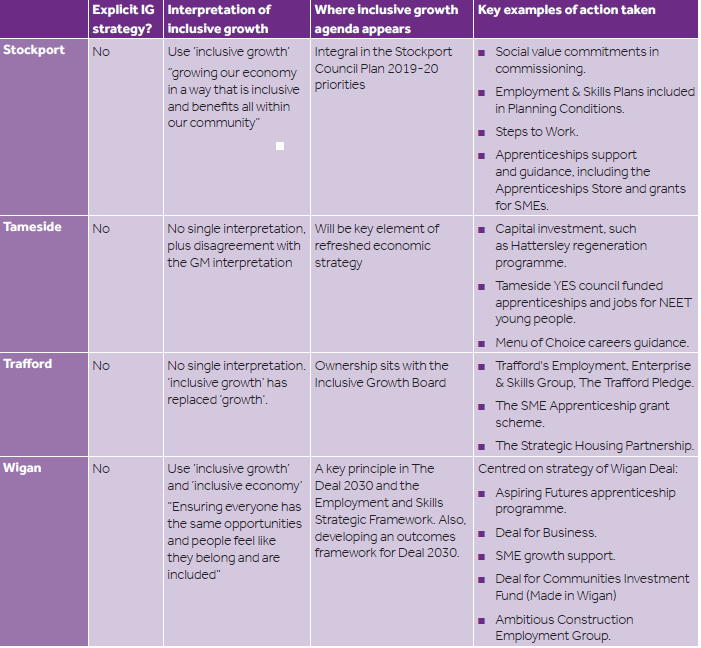
Table 1: Summary of Adoption of Inclusive Growth in GM Local Authorities. Sourced from conversations with the Local Authority Inclusive Growth Network and publicly available Council documents.
Table 1: Summary of Adoption of Inclusive Growth in GM Local Authorities. Sourced from conversations with the Local Authority Inclusive Growth Network and publicly available Council documents.
A plurality of views, political objectives and different organisational usages is to be expected and should not be seen as problematic, given the principles of subsidiarity which underpin CA/LA relationships and the spirit of collaboration and co-ownership which now underpins GM policy-making. However the lack of a clear articulation of what the CA means by inclusive growth and what actions it therefore intends to take at GM level could hinder progress in a number of ways. If the term is not clearly understood, it makes it harder to align and integrate the interests of ‘growth actors’ (such as politicians and officers responsible for economic development, and business leaders) with those of ‘inclusion actors’ (politicians and officers responsible for public services, and leaders of voluntary, community and other social economy organisations). Goals to improve both growth and inclusion may co-exist but in silos. It will be harder to see why social investment or measuring impacts on poverty should be the concern of ‘growth actors’, or how economic strategies might need to be reconfigured to produce better social outcomes. Equally it will be harder to see how inclusive growth and carbon reduction strategies might be linked, or inclusive growth and digital strategies. Arguably this then weakens the power of inclusive growth as a shared mission to which other stakeholders can respond and contribute, and which they can shape. It may make it more difficult to put leadership, delivery and accountability mechanisms in place to support a long term inclusive growth agenda.
Structures, delivery and measurement
Consistent with its decision not to adopt the terminology of inclusive growth as a central mission, GMCA has not established any central unit/resource to develop its inclusive growth policies and actions ensure their embeddedness across multiple areas of policy. This approach contrasts with that of the West Midlands combined authority (WMCA), which has established an internal Inclusive Growth Unit, to ensure that inclusive growth is “hard-wired” into mainstream West Midlands investment, economic growth and local industrial strategy. The Unit provides research, analysis, insight and citizen engagement to support more inclusive policy and investment decisions, and is intended to give long term strategic support for the WMCA and its public service partners within the region. The existence in GM of IGAU as an independent evidence resource and convenor of stakeholders may be a factor in GM’s different approach. GM has also chosen not to allocate a political portfolio holder within the Mayor’s Cabinet responsible for inclusive growth. Current portfolios most relevant to inclusive growth are those for: ‘the economy’, ‘education, skills, work and apprenticeships’; ‘community, voluntary and co-ops’; and ‘age-friendly and equalities’. However almost all other portfolios could have an element relating to inclusive growth.
Specific inclusive growth metrics, based on a re-thinking of what inclusive growth means and what measures would signal success, have also not yet been developed in GM. IGAU’s research suggests that there are many different approaches to inclusive growth measures, some more radical than others. Some simply involve measuring indicators of inclusion alongside measures of growth or prosperity. Some involve attempts to combine indicators in a single measure, so that the value of economic output is effectively weighted by the extent to which other social goals are achieved. Some keep multiple existing measures of growth and of social outcomes such as education and health, but pay much more attention to their distribution between places and population groups. Others develop frameworks which give more attention to citizens’ understanding of the meaning and value of growth and inclusion, or to the conditions and processes which underpin inclusive growth (such as resilience, participation or social and cultural infrastructure).
GM has developed an extensive outcomes framework to support the delivery of the GMS. This includes inclusive growth metrics at the level of priorities, particularly “good jobs with opportunities to progress and develop” and “a thriving and productive economy in all parts of Greater Manchester”. Elements of this framework are supported by performance dashboards, reported to the relevant body in the governance structure. This, in our view, represents advanced progress in command of data for monitoring purposes. Four things have not yet emerged or become established:
- A smaller set of high-level measures that would represent progress on inclusive growth, which might enable impact assessment tools to be developed for proposed policies or investments.
- Deliberative processes to determine priorities and trade-offs.
- A clear understanding of the relationship between measures across policy areas and the relationships between them. For instance, what measures of culture or social participation would support developments in skills, health and jobs?
- A critique of, or challenge to, existing goals or measures based on broader citizen participation and debate.
Turning to the question of wider involvement in leadership and governance, our consultation suggests that significant steps have been taken in recent years and particularly since 2017. These include the establishment of the VCSE reference group, a Mayoral accord with the VCSE sector, and various initiatives to increase voice and representation from marginalised groups (see Chapter 8). As we have documented in other work, devolution to GM has in any case (regardless of inclusive growth) fostered an increase in formal and informal partnership working and collaboration across local authority boundaries, across sectors and within and across policy boundaries. Examples include GM’s Ageing Hub, partnerships formed around the Mayor’s homelessness agenda, and the Education and Employability Board which brings together schools, colleges, universities, local authorities, DfE, Regional Schools Commissioner, GMCA, the LEP and others. High level VCSE representation has been sought for the GM Housing Commission. The University of Manchester has taken a lead with the Centre for Local Economic Strategies and GMCA in establishing a steering group to develop an ‘anchors initiative’ in GM. A number of local authorities in GM, particularly Wigan (the Wigan Deal), Manchester (Our Manchester) and Oldham (Co-operative Council/’Our Bit, Your Bit’) have sought to foster new relationships with communities, including community investments funds, asset ownership and wider involvement in decision-making. Since 2017, cross-GM conversation, partnership working and strategy formation have been mobilised on specific issues through ‘summits’ (on school readiness, social enterprise and the economy) and through formal commissions (on Cohesion and on Cooperatives). However, in respect of ‘inclusive growth’ as a whole, IGAU’s multi-stakeholder advisory board remains the key forum for discussion and representation. Our consultation also raised questions about effective representation of diverse communities, and of different parts of the VCSE sector (with voluntary, community and social enterprise elements all having very different perspectives and expertise).
Finally, we note the challenges of financing inclusive growth strategies, in the context of limited and piecemeal devolution to city-regions, a long period of austerity, and the phasing out of local government revenue support grant. Inclusive growth raises resource questions in multiple ways including but not limited to: how to finance the delivery of work at the city-region level such as good employment charters, policy development and appraisal; how to fill gaps in public funding or enhance services to meet city-region priorities (for example in relation to skills or transport); how to support innovation and evaluation; how to pool existing public and private resources in new ways; and how to increase access to finance for local business growth. Proposed solutions include establishing local financial institutions to enable local saving and lending; local investment of anchor institution assets and funds; municipal or social investment bonds; and municipal ownership or community ownership of local public assets. Devolution from central government and the capacity to pool budgets across service areas is a key issue, as will be any future settlement relating to the distribution of regional funds following the UK’s exit from the European Union (EU).
As we document throughout this report, new inclusive growth initiatives in GM are being financed in a variety of ways, including levies on taxpayers through the Mayoral precept, ‘earnback’ arrangements with central government, retained business rates, local authority and business contributions. GM Mutual, a local bank, was registered with the Financial Conduct Authority in 2019, with support from several of the GM districts, the GM Chamber of Commerce, the Federation of Small Businesses, and third sector organisations, but plans are still at early stages. As work on inclusive growth develops in GM there will be a continuing need to identify costs, benefits and financing mechanisms, including through any further devolution settlements following the government’s recently announced White Paper on devolution.
Learning from other places: see case studies 1,2,3,4
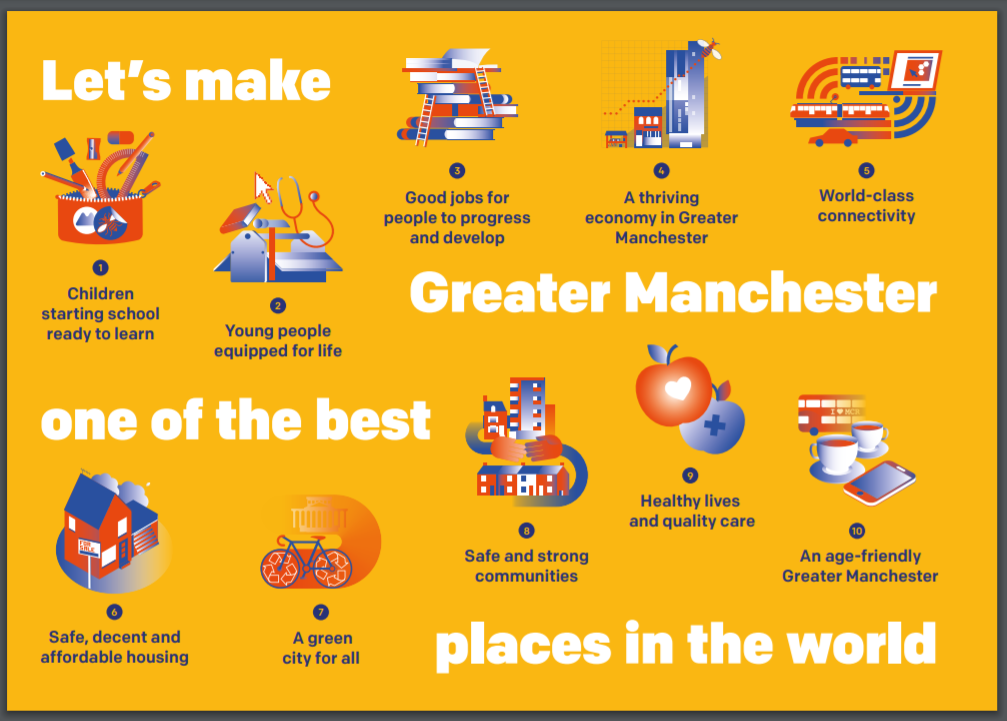
Box 5: The 10 Priorities of the Greater Manchester Strategy. Source: Greater Manchester Combined Authority
Box 5: The 10 Priorities of the Greater Manchester Strategy. Source: Greater Manchester Combined Authority
5. Towards a more inclusive economy
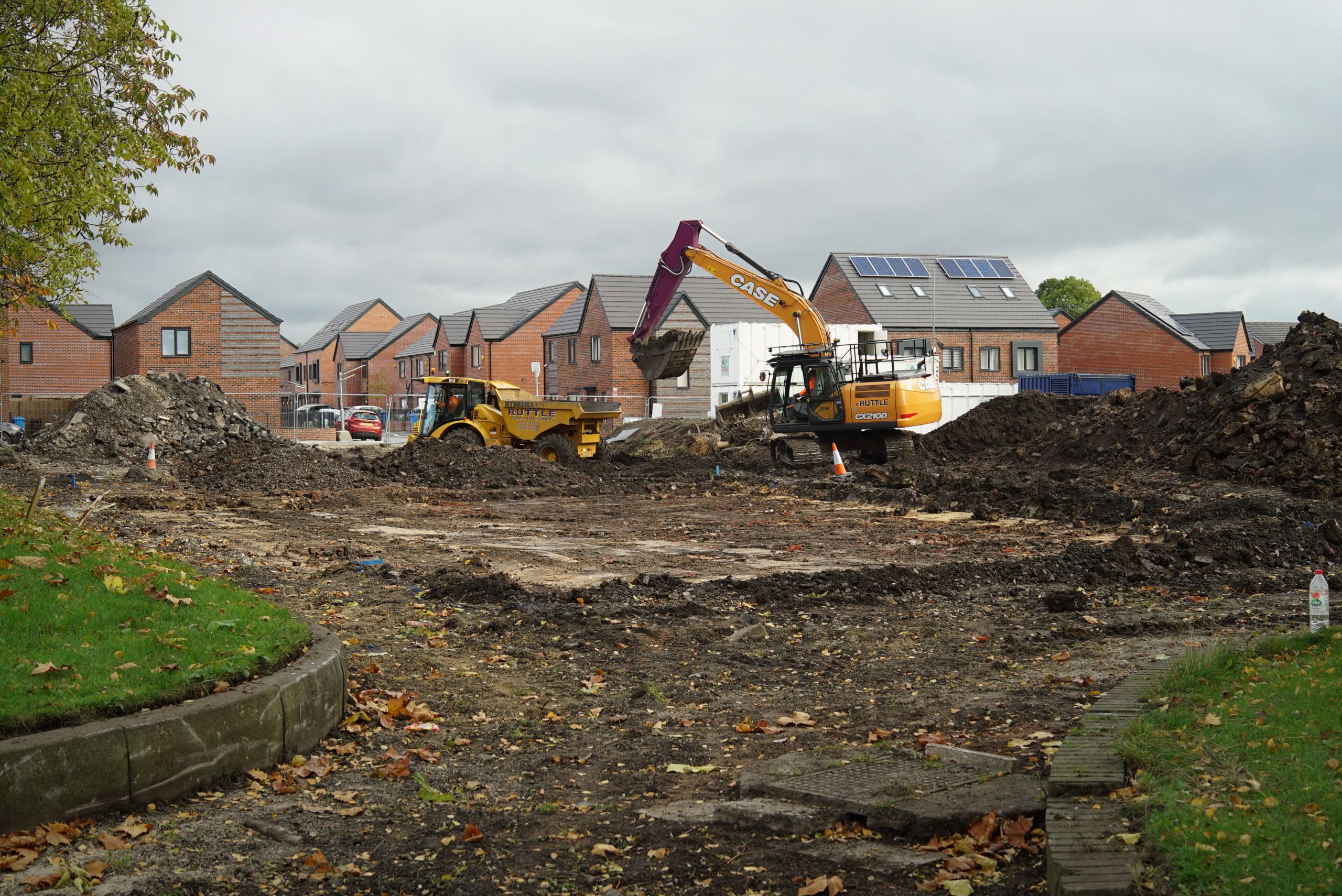
Key points:
■ Inclusive economy activities aim to change the way the economy functions in order to achieve a fairer distribution of economic opportunities and to deliver wider social and environmental benefits.
■ Policies that develop some of these ideas have begun to emerge in GM, including around promoting good employment practices, efforts to develop and support different types of economic activity, and recognition of the importance of the ‘foundational economy’.
■ Much of this activity is still in the early stages. GM needs to go further in embedding a commitment to build an inclusive, resilient economy with good jobs for residents.
■ Examples from other places suggest that cities can develop systemic and long-term approaches to supporting the growth of local businesses that can offer good jobs to residents. Recent examples include offering dedicated funding to support the development of inclusive economy initiatives and efforts to re-organise care services in line with co-operative principles.
Making local economies more inclusive
An inclusive economy is one where economic structures and activities are more inclusive by design, reducing inequalities and delivering wider social benefits. It rests on the idea that the economy is currently ‘exclusive’, therefore requiring intervention in key markets, sectors, business ownership models and the flow and distribution of assets and resources. The economy is re-framed as the product of collective decisions about the organisation of production and exchange – decisions which can be unmade in order to change the ways that resources are distributed, governed and owned. A better society and standard of life, good services and infrastructure and strong relations between community members are priorities, rather than economic growth in and of itself.
A key plank of local inclusive economy strategies is supporting employer behaviour that raises wages, improves job quality and builds opportunities for in-work skills development and pay progression. Approaches include employment charters, living wage policies, support for job redesign and work re-organisation in low paid sectors. Public procurement and commissioning may also be used as tools to promote better employment practices.
More broadly, cities can adopt economic strategies that, over time, support the development of activities, sectors and types of economic organisation that are more likely to deliver high quality employment for local residents as well as social and environmental benefit. These can include various forms of ‘growth from within’ approaches, rather than focusing mainly on attracting external investment, as well as strategies to stimulate employer demand for higher level skills and better use of existing skills. Places can support co-operatives and social mission focused organisations to produce core services and goods, creating a more diverse and therefore potentially more resilient economy as well as better outcomes for residents, and workers. Some make the case for treating ‘foundational’ types of activity differently, with utilities, health and social care subsidised, organised and delivered on a low risk, low return basis. Municipal ownership of assets and utilities, or co-ownership models, may also be considered.
Inclusive economy policies in Greater Manchester
From our reading of the Greater Manchester strategies, and GM-level policies, inclusive economy policies were not especially prominent in GM before 2017. However, there are some promising recent developments.
The Good Employment Charter is a particularly significant development in this area. The Charter was part of the mayor’s manifesto but has been developed through consultation with employers, unions, and employment specialists and researchers. Launched in July 2019, it is being piloted with a small group of employers who will help to set the criteria for membership. Rather than just aiming to recognise the ‘best’ employers, the charter aims to support all employers in the city region to identify how they can adopt better employment practices across seven broad themes (see Box 7). The charter has great potential but a number of challenges lie ahead.
Our review of local employment charters found that previous initiatives tended to engage a relatively small number of employers directly, in terms of accreditation and membership. However, they can play a more indirect role in initiating wider conversations and raising expectations around good employment. For GMCA, and its constituent LA members, the implementation of the charter could have a significant impact through highlighting how these organisations could improve employment practices, as well as the impact that they have in setting employment standards beyond the local authority, e.g. around commissioning of services and investment decisions. In terms of wider engagement, it is likely that significant time and resource will need to be invested to achieve the ambition of working with all employers, including those in lower paid sectors, small and micro-businesses, particularly where changing practices will have a direct impact, at least initially, on business costs. Careful integration of the charter into GM’s social value strategy and investment funds could provide strong incentives for some employers to engage with the charter.
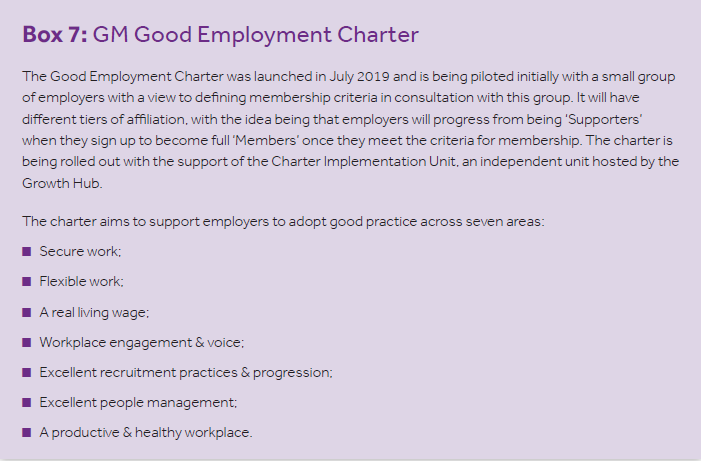
Box 7: GM Good Employment Charter. Source: https://www.greatermanchester-ca.gov.uk/what-we-do/economy/greater-manchester-good-employment-charter/
Box 7: GM Good Employment Charter. Source: https://www.greatermanchester-ca.gov.uk/what-we-do/economy/greater-manchester-good-employment-charter/
Turning to other business-focused policies, the Growth Company (GC) is the umbrella body in GM which brings together a range of businesses and organisations supporting growth and job creation activities across the city region. In this role, it is tasked with helping to deliver against the ambitions of the GMS and has enthusiastically adopted the ‘inclusive growth’ framing within some key areas. The Growth Hub, which is part of the GC and which coordinates a range of business support services, has trained its advisors to ask those businesses who engage with their programmes a core set of ‘diagnostic’ inclusive growth questions. These questions aim to determine whether the business: pays the Living Wage; uses zero hours contracts; supports volunteering; and supports local suppliers. Business may then be referred to advisors within the Growth Hub to discuss how they might adopt these practices. However, at present the extent to which these questions lead businesses to think about how they might offer, for example, better pay, or more secure contracts is not clear. Depending on quality, the data collected by advisors could be used to track business practices, and/or the number of employers who subsequently engage with support to change these practices. This could also be helpful in planning future support services, giving an indication of the demand for more intensive support and whether this should be targeted. An Inclusive Growth steering group, which was recently set up within the Hub, could review this activity, as well as considering what other diagnostic data could be usefully connected.
The GM Business Productivity and Inclusive Growth programme, which has attracted £45 million in funding, is also being led by the Hub. The overall programme is primarily targeted at businesses with ‘the greatest potential and ability to grow and/or improve their productivity’67, including sectors with growth potential (like health innovation and advanced manufacturing) and large employment sectors (like retail and hospitality). The overall programme has the potential to support inclusive economy activities. One strand within the programme, the Large Companies Support programme, aims to help large companies to become more resilient in the face of changing markets and economic shocks through support to plan for the future. Other strands are supporting innovation and carbon reduction, with match funding from the European Regional Development Fund. Currently, the number of businesses engaged and the number of jobs created are the main targets against which progress is being reported across the different strands of activity, so it is difficult to determine the level of engagement across sectors, the types of jobs that have been created and how far this might be supporting companies to transition to a fairer, or greener approach. Outside of the Productivity and IG programme, the Hub is also working with the Chamber of Commerce to encourage small and medium-sized employers to take on apprentices.
A range of networks, organisations and policies are promoting the use of social value within GM. There is a Greater Manchester Social Value policy, currently under review, which supports information sharing, training and networking around social value across GM. As a part of the wider GMS, Greater Manchester is aiming to embed ‘quality jobs, skills provision and career progression’ as core outcomes for all skills and work contracts. For example, in 2018 the contract for the Work and Health programme was awarded to InWorkGM, a partnership between Ingeus and three social enterprises, including the Growth Company. The partnership has committed to deliver a range of social value commitments, including: ensuring that employees are paid the Living Wage; offering leadership development workshops to voluntary and community sector organisations; and ensuring that they recruit a diverse range of people, with at least 35% of people from ‘priority characteristics’ such as young (16-24) and older (over 50) people, ex-offenders, and those with a disability or health condition.
Aside from the commissioning process, parts of the Work and Health programme have also been adjusted with the aim of promoting better employment outcomes for participants. GMCA has varied the payment by outcomes model so that providers will be paid an ‘earnings fee’ if they support participants into work that pays the equivalent of the Living Wage for a specified number of hours and period, this is in contrast to the national programme which pays providers based on the National Living Wage. As a large share of the funding for the programme (around 45% of what was budgeted in 2018) came from EU funds it is as yet unclear what will happen when this funding expires. A more recent development which has the potential to considerably strengthen activity around the inclusive economy is the Co-operative Commission for Greater Manchester. This is an independent panel set up in 2018 to help identify ways to support the development of the co-operative sector in GM, and the role of the Combined Authority in enabling this activity. While the Commission is not due to report before this paper goes to press, initial findings indicate that GM has a relatively underdeveloped co-operative sector but that there are opportunities to strengthen support for the sector. Commission hearings have focused on housing, transport and digital sectors and ways to support the development of co-operative businesses. Alongside the Commission, a Social Enterprise Strategy is also being developed, which will set out how the sector can support the implementation of the GMLIS, whilst also promoting good jobs and innovation. The GMLIS also committed to developing a plan for the ‘foundational economy’, including looking at ways to improve productivity and job quality in these areas.
The strategy, and the GMIPR, gave significantly more attention to the importance of pay, job quality, skills and progression in the large low paid sectors which make up a large part of the GM economy than its predecessor, the Manchester Independent Economic Review (MIER). However, it is as yet unclear how the foundational economy is understood in this context – whether it is being used in a more limited way as shorthand for ‘low paid sectors’, or a more expansive way including utilities and elements of ‘social infrastructure’ such as education and health. It is also as yet unclear how the plan for the foundational economy will be integrated into the wider GMLIS and the implementation plans that are being elaborated around it: failure to do so could marginalise and limit the potential of this commitment. Inclusive economy activities are also being explored and implemented by individual local authorities. Manchester has recently developed a Local Industrial Strategy, which is aligned to the GMLIS and explicitly aims to create a more inclusive economy for the people who live and work in the area. The strategy outlines plans to create quality job opportunities in the foundational economy, including working with anchor institutions. Several local authorities have committed to increase their use of social value within contracting and procurement, including adopting a 20% social value weighting when assessing tenders (e.g., Manchester, Stockport, Tameside). Many local authorities are taking steps to monitor their spending and increase the proportion that goes to local suppliers: Oldham’s community wealth building approach, for example, brings together the local authority with other local anchor institutions to increase local spend and create employment opportunities for residents. Moving beyond contracting, Salford has introduced the 10% better social value campaign, which is asking people and organisations from the third, public and private sector within Salford to make a pledge to help them to meet a variety of goals, including reducing waste, increasing recycling, increasing volunteering and increasing the number of people who are paid the Living Wage. Similar commitments also feature in the Wigan Deal, and the Deal for Business. Meanwhile, Rochdale Council is targeting some financial support, such as business rate relief, at organisations that are judged to be offering jobs with progression and development opportunities. Our consultation also suggests that housing providers are increasingly involved in building inclusive economies in their areas. There are examples from around GM of: facilitating networks of local businesses; providing enterprise advice, business skills workshops and signposting to small business grants; and grant-funding community business start-ups and consolidation, including targeting under-represented groups. Housing providers also support local social businesses through their own procurement processes. Overall, this account suggests that that there has been an emergence and strengthening of inclusive economy policies in GM in recent years. However, current initiatives are still in their early stages, rely on ad hoc funding or have been established on a short term basis, so work will be needed to put activity in this area on a more sustainable footing capable of supporting a longer term transformation of economic activity.
While the GMLIS certainly signals a shift to a more plural approach to economic development, this has not yet been turned into a clearly integrated strategy, located within the city region’s growth narrative, which links the different developments (on responsible business, low paid sectors, and the social economy). GM has also not yet pursued some of the more ‘progressive’ or ‘radical’ ideas emerging around local ownership and governance, although the report of the Co-operative Commission may initiate moves in this direction. GM could also prioritise support for initiatives that aim to reduce the insecurity and low pay experienced by workers in the gig economy, e.g. the development of digital co-operatives platforms.
Learning from other places: see case studies 5,6,7,8.
6. Connecting people to opportunities
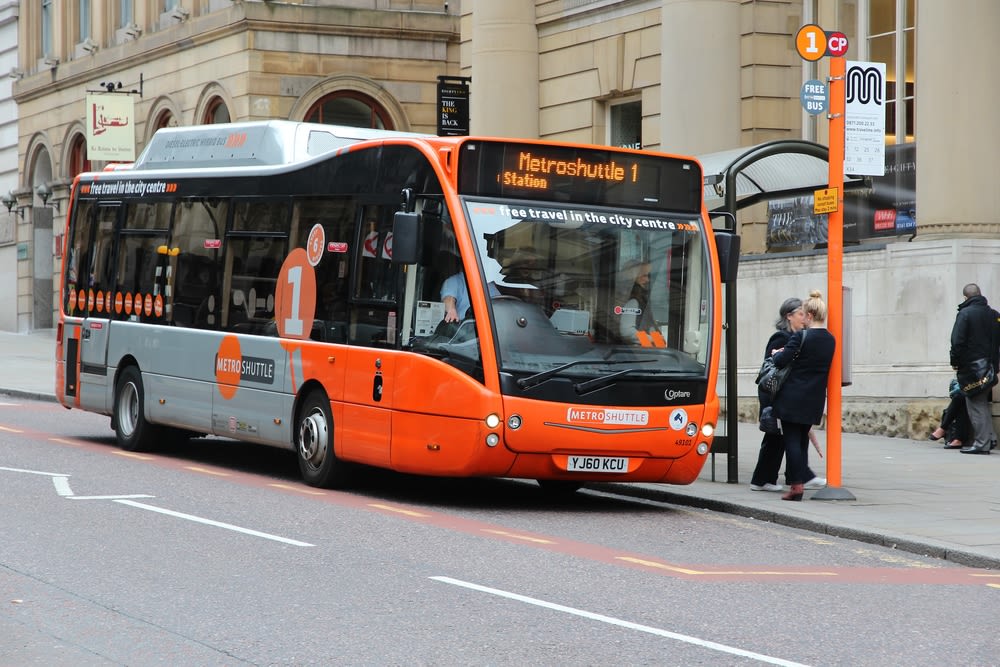
Key points:
■ People can be connected to economic opportunities and enabled to live well by investing in quality
services and infrastructure, and through targeted initiatives to strengthen the links between
economic and social policies.
■ GM has already made substantial progress particularly in the area of work and skills, and through its
public sector reform programme.
■ Key next steps will be to maximise the inclusive growth benefits of local bus franchising, as well as to
ensure that inclusion is a central feature of strategies for growth sectors, including in green industries.
■ GM also needs to develop a strategic approach to its education and training system, as it has done
with health and social care.
■ Examples from other places illustrate how cities can take a system-wide approach to improving
education outcomes, connect disadvantaged groups to new sectors and opportunities and subsidise
travel to improve access.
Connecting people to opportunities
In addition to developing an economy that is inclusive by design, another major sphere of inclusive growth activity relates to making sure that local people are connected to economic opportunities, through improving physical and social infrastructure and making access more equitable. This is more familiar policy terrain than some of the ideas discussed in terms of developing more inclusive economies since it typically falls within mainstream policy debates – on affordable housing, transport connections or digital infrastructure, or education and training, health, care and, often neglected in relation to inclusive growth, culture and leisure.
In the context of inclusive growth, city-regions have two main challenges in dealing with these issues. The first challenge is to make universal and targeted public services work in ways which significantly shift long standing inequalities in human, social and cultural capital, while at the same time facing rising costs and needs and reduced spending. Devolution of powers to city-regions creates an opportunity for innovation and transformation through the joining up of services and budgets in place.
The second challenge is to link social and economic policies more closely. This could mean designing social policy interventions directly to support economic strategies – for example developing holistic approaches to tackle health-related barriers to employment. It could mean designing economic strategies and actions in ways which bring more equitable social benefits, for example by developing strategies for growth sectors which enable people who would not typically benefit from these to access sustainable and high quality training and work opportunities. Other examples include working with employers on job design, recruitment, and entry requirements in order to widen opportunity; developing accessible learning (including for those in low wage work who want to progress), and supporting residents to adjust to changes in the types of jobs that are likely to be available over the short and long-term. Box 8 provides some examples of key ideas that connect to these priorities and challenges.
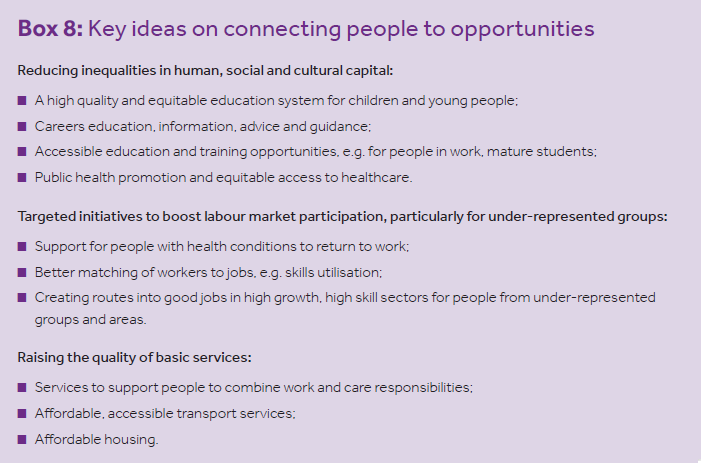
Box 8: Key ideas on connecting people to opportunities
Box 8: Key ideas on connecting people to opportunities
Education, skills and work
Improving educational opportunities and skills, and providing stronger routes into and through the labour market have been key priorities in GM’s approach to inclusive growth.
Successful transitions into the labour market for younger people are prioritised in the GMS through the ‘life ready’ agenda. Key initiatives include ‘Bridge GM’, which offers a framework for careers advice and guidance and work experience, and the Our Pass pilot offering free bus travel for 16-18 year olds. Bridge GM includes an ambition for all young people to have an ‘encounter’ with an employer in each year that they are in compulsory education. An apprenticeship portal has also been developed for young people studying with the colleges and training providers that are members of the Greater Manchester Apprenticeship Company, providing access to vacancies data and CV advice to support young people to think through next steps. In addition, an online ‘Levy Matchmaking Service’ has also been introduced which aims to create more apprenticeship opportunities for people in GM by enabling large apprenticeship levy-paying employers in the city region to transfer some of their unspent levy funds to small employers.
A free 16-18 bus pass, ‘Our Pass’, is being piloted for two years from September 2019 at an estimated cost of around £16 million. The pass aims to ensure that travel costs do not prevent young people from accessing or continuing with education, training or employment opportunities, setting them up for a prosperous working life. It is also anticipated that the pass may help to promote the use of public transport more generally and allow young people to experience the cultural opportunities that GM offers. The cost of the scheme is to be funded partly from the Transport Levy and Earnback monies, as well as potential contributions from businesses and/or education and skills providers.
A number of targeted initiatives are also working with young people and other groups to try to improve access to education and work opportunities. This includes Talent Match and the new ‘Hidden Talent’ programme. For example, the youth panel for the latter project is holding workshops to review employers’ recruitment materials to check how accessible they are for young people. GMCA is also hoping to increase the take up of apprenticeships among under-represented groups, including BME young people and, in partnership with the GM Ageing Hub, older people. Here the idea is that apprenticeships can provide a route into work, as well as an opportunity for people to change careers or to support a return to work.
Providing better support for residents who were out of work and otherwise disconnected from the labour market was one of GM’s early priorities under devolution, with the development of a pilot initiative to improve employment outcomes for incapacity benefit claimants (the Working Well pilot initiative). The pilot ran from 2014 to 2016 and was designed and jointly funded by GMCA and Department for Work and Pensions (DWP). It was subsequently expanded and led to GM securing a co-commissioning role in the DWP’s Work and Health programme (see Chapter 5), before evolving more recently into a wider ‘whole population approach to work and health’. The goal is to offer interventions across the ‘employment lifecycle’ to ensure that people can stay in or return to work where possible and a ‘skills and work system that enables people to realise their potential, supports emerging industries and is responsive to employers’ (GMLIS, p.10). This includes not just employment support programmes for those out of the labour market but reforming training opportunities, and attempting to influence employer demand through the employment charter and other initiatives. Other targeted support is being developed for older residents (aged 50+) and the GM Health and Social Care Partnership (GMHSCP) has developed a working carer toolkit targeted at employers and carers which outlines examples of good practice that can enable people to combine caring with paid employment.
Other skills developments include proposals that have been brought forward for the devolved Adult Education Budget, including the offer of free education and training up to a Level 2 qualification (roughly GCSE A*-C) for residents with low or no qualifications, and for people in employment on a low wage. With the right support and advice, this could enable people with low skills to access qualifications that will enable them to enter and progress in work. A partnership has been established between GMCA, DWP and DfE to explore better co-ordination of post-16 education and training as part of the GMLIS.
Also at a strategic level, workforce development plans are being developed in education, health and social care sectors. An early years workforce development plan, along with a linked Academy, underpins ambitions to transform the way that early years provision is provided and enable the early identification of need, including special educational needs and disability.
More broadly, the GMLIS highlights the need to address anticipated skills demands in GM’s priority sectors, supported by a proposed £8 million investment pot from the Local Growth Fund. There are specific proposals for key sectors including outline ideas for a centre of excellence around modern methods of construction, and ambitions to create a digital skills pipeline and a £3million digital skills pilot. In addition, GM’s ambition to be carbon neutral by 2038 creates new skill demands and opportunities. Activities are beginning to be outlined in the GMLIS implementation plan, the Manchester LIS and GM’s 5-Year plan for the Environment, including consultation around the kinds of skills that will be needed to ‘deep’ retrofit buildings in GM. There is scope to draw stronger links between this activity and more targeted efforts to connect people to these opportunities; for example adults with lower skills or who are out of work, people who could progress into better paid work through retraining; and young people in areas or groups currently under-represented in these industries and/or in the GM labour market in general.
Local authorities and local organisations are also coordinating a range of skills and employment initiatives targeting people who are out of work, and aiming to support residents to enter and progress in work. While there are too many to review individually, examples include Oldham’s pilot Career Advancement Service, setup in 2016, offering intensive career coaching and a personal training budget to low-skilled participants who had accessed its employment entry programme ‘Get Oldham Working’. Manchester funds the My Future Intermediate Labour Market scheme, which offers young people who are not in employment, education or training a 4 week accredited pre-employability programme followed by a three month paid placement which should be linked to a paid job opportunity or apprenticeship with the employer. Rochdale is supporting employees in sectors facing technological change and re-structuring to prepare for jobs in other sectors. The goal of connecting residents to employment is also supported by a range of local organisations. GM housing providers have introduced targeted services for residents, meanwhile ‘Recode’, a Community Interest Company, ran its first free 12 week coding course in Bolton over the summer of 2019, aiming to support people to access a career in software engineering.
A major sticking point in relation to further education, skills, and lifelong learning remains the current organisation of the education and skills system. Although the GMS sets targets for educational achievements at the end of primary and secondary school, school education has never been the responsibility of any regional or sub-regional body, instead residing either with central government or local authorities (and increasingly with individual schools and multi-academy Trusts). Capacity to influence educational achievements and equity in the years up to 16 is therefore very limited. Young people are now required to stay on in full time education or training until age 18, but the post-16 provider landscape is a complex one with multiple schools, colleges and independent providers facing competing incentives and very limited local oversight. GM has made some first steps towards a strategic approach to compulsory education in the establishment of an Education and Employability Board, which has adopted a focus on ‘championing the vulnerable’ and ensuring equity in the education system. In practice however, the board has neither delegated responsibilities (from DfE) nor funding from GMCA. Strategic approaches to workforce and professional development as envisaged in health, social care and early years have not yet been developed in this area. An important development in this respect was a GMLIS agreement to a partnership with central government to review the post-16 education, skills and work system, reporting in March 2020. This offers a significant opportunity to set out how greater local coordination could address some of the problems caused by the current system fragmentation.
As we indicated in Chapter 2, transport is a key issue in improving access to skills and work, as well as enabling inclusive access to the broader opportunities of the city-region. The Greater Manchester Transport Strategy 2040 lists as an ambition, “to develop a fully inclusive and affordable transport system for all”, pledging to make public transport not just affordable for low-income groups, but accessible for elderly people and people with disabilities. The importance of orbital transport is recognised, as well as the role of transport in broadening employment opportunities for those living near planned employment developments outlined in the GMSF. A key development is bus franchising, which would allow Transport for Greater Manchester (TfGM) on behalf of GMCA to set routes, timetables, fares and standards. In October 2019, GMCA became the first city-region to consult on a bus franchising scheme. In addition, an early bird fare scheme was trialled on GM’s Metrolink tram system in 2018, with a view to the possible development of a ‘pre-peak’ offer – designed to relieve congestion but potentially also of value to low income shift workers.
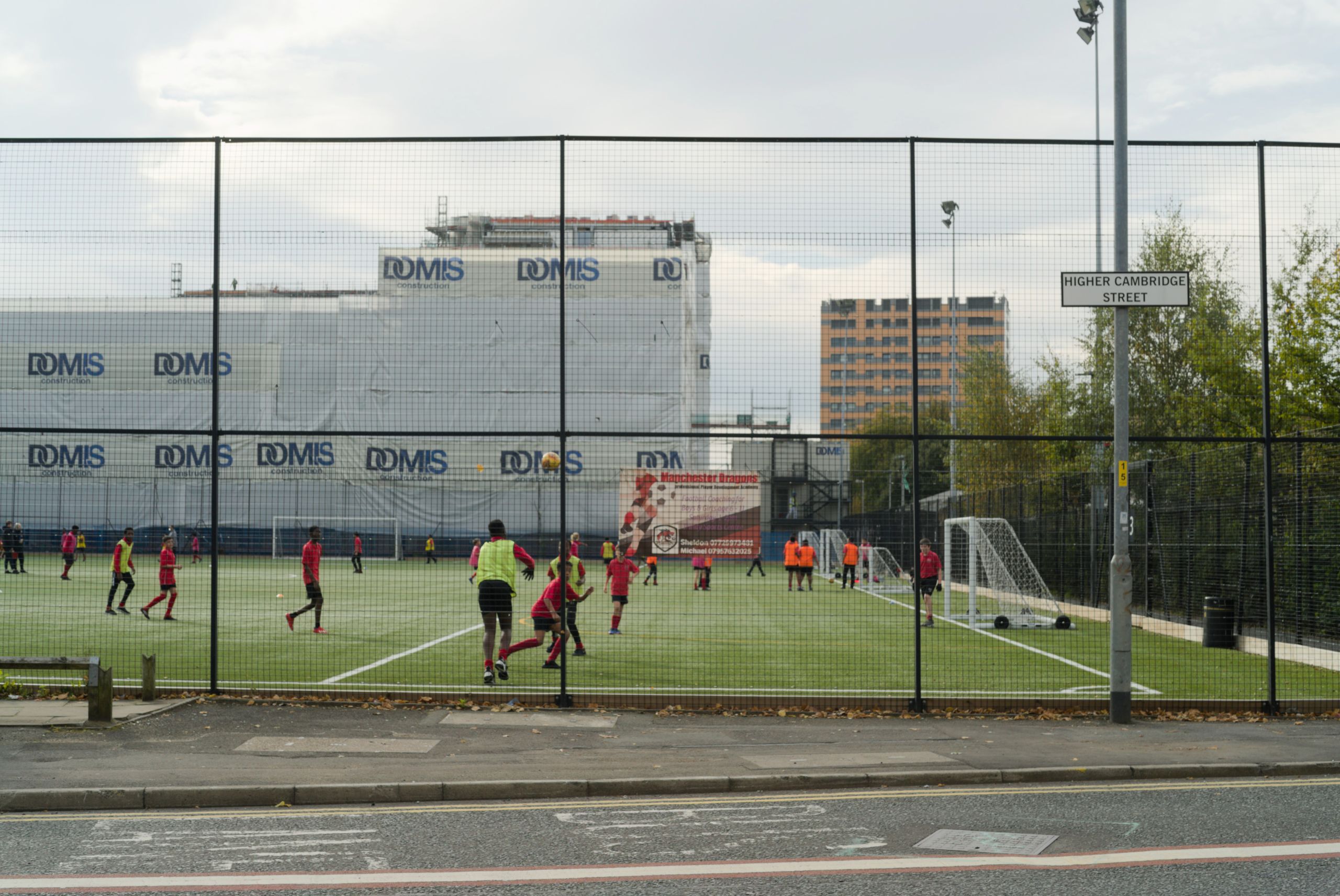


Wider public service reform and integration
Beyond education, skills and transport, there has been extensive activity around better public services in GM as part of a decade-long public service reform programme and the increasing devolution or delegation of powers and responsibilities from central government. Central to this is health and social care reform, which, with its emphasis on prevention, local integration and innovation, is seen as a major opportunity to address the poor population health outcomes and inequalities identified at the start of this report. Other key planks include early childhood development, recognised as part of GM’s inclusive growth approach since the MIER in 2009, and given a new impetus in 2017 (renamed ‘school readiness’) as the first priority of the GMS. Since 2012 the ten local authorities and partners have been working on the implementation of a new Early Years Delivery Model comprising universal and targeted services. From 2017, a new School Readiness Board and programmes of work have been established, including embedding best practice in particular delivery areas, digitising assessment processes, and establishing the early years workforce academy to improve the training and support of staff working in early years settings. Housing has been a particular priority of the Mayor, who has made high profile commitments to end rough sleeping and reduce homelessness by 2020, and has indicated more recently that he would like further powers in this area (e.g., to vary Local Housing Allowance, and to address poor housing standards). The GM Housing Strategy (2019) details plans to improve the condition of the existing housing stock and deliver new homes in the ‘right places’. With regard to social housing, there are plans to increase delivery of new social and affordable housing and review the allocation process, as well as ambitions to scrap Right to Buy, which would require national government approval. Proposals to integrate social housing providers with the health and social care system are also put forward, with the example of developing supported housing for older households with care needs.
All of these developments contribute to inclusive growth, and it is a notable development that the GMIPR (and GMLIS) placed a strong emphasis on health and on health and social care reform as a “nationally unique opportunity to find new ways to improve the health of local residents, and link health interventions with local skills provision and other services to improve progression in work and address long-term unemployment among older age groups and people with multiple or complex needs” (GMLIS p27). This is not the traditional domain of industrial strategy and demonstrates a strong link between the work of ‘growth actors’ and ‘inclusion actors’.
In 2019, the GM public service reform agenda took a major step with the publication of a ‘white paper’ setting out a unified public services model. Building on developments in the last decade, this sets out a “completely new approach to public service” which will “completely break down the silos which exist between public services”. Instead of organising around themes or policy areas, the new model will organise people and budgets around neighbourhoods of 30,000-50,000 residents, each an integrated place-based team, with co-located professionals from all public services working together. Public services are defined broadly, to include formal services, voluntary, community and social enterprise sector, local businesses and assets within communities. Box 9 sets out key features of the model, including geographic alignment, integrated leadership and a single workforce, shared financial resources and shared programmes and delivery. Importantly, the development of these neighbourhood teams is also identified as an important element in the implementation plan of the local industrial strategy. Neighbourhood teams bring together local actors who can help to improve health and well-being, and facilitate the embedding of health priorities across a range of policy areas, including tackling poor housing, supporting access to and retention of work, tackling loneliness and debt advice.
Learning from other places: see case studies 9,10,11,12.
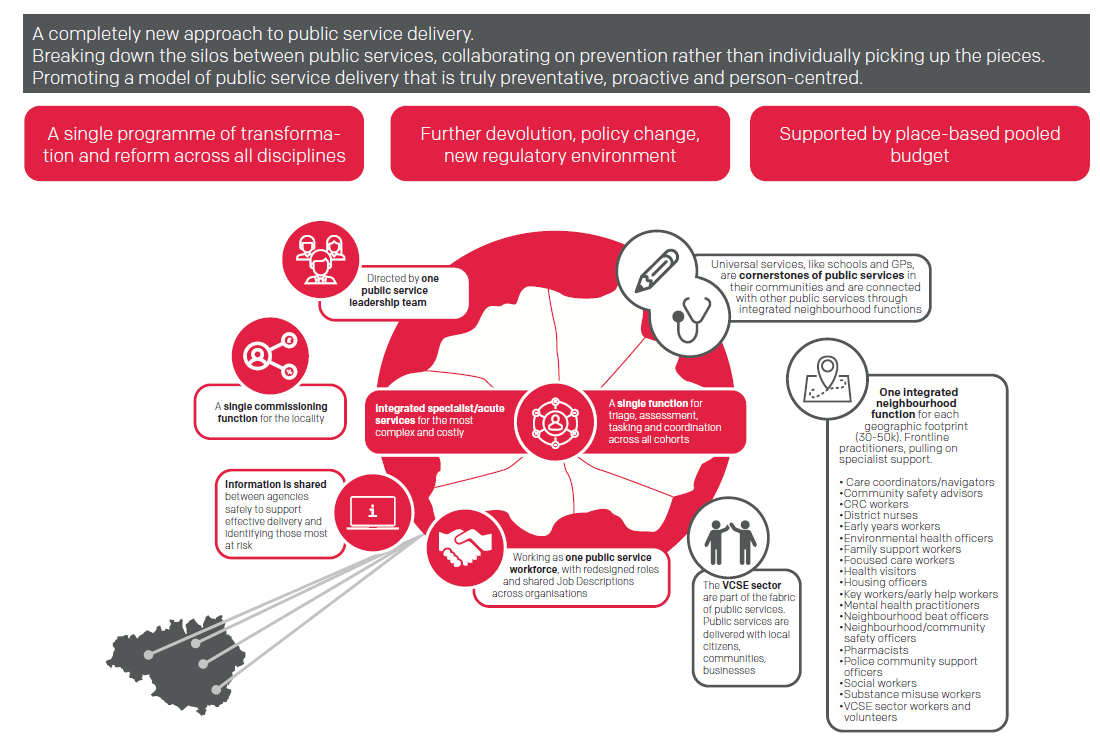
Box 9: The Greater Manchester Model of Unified Public Services. Source: GMCA (2019). The Greater Manchester Model - White Paper on Unified Public Services for the People of Greater Manchester, GMCA 26th July 2019
Box 9: The Greater Manchester Model of Unified Public Services. Source: GMCA (2019). The Greater Manchester Model - White Paper on Unified Public Services for the People of Greater Manchester, GMCA 26th July 2019
7. Addressing spatial inequalities
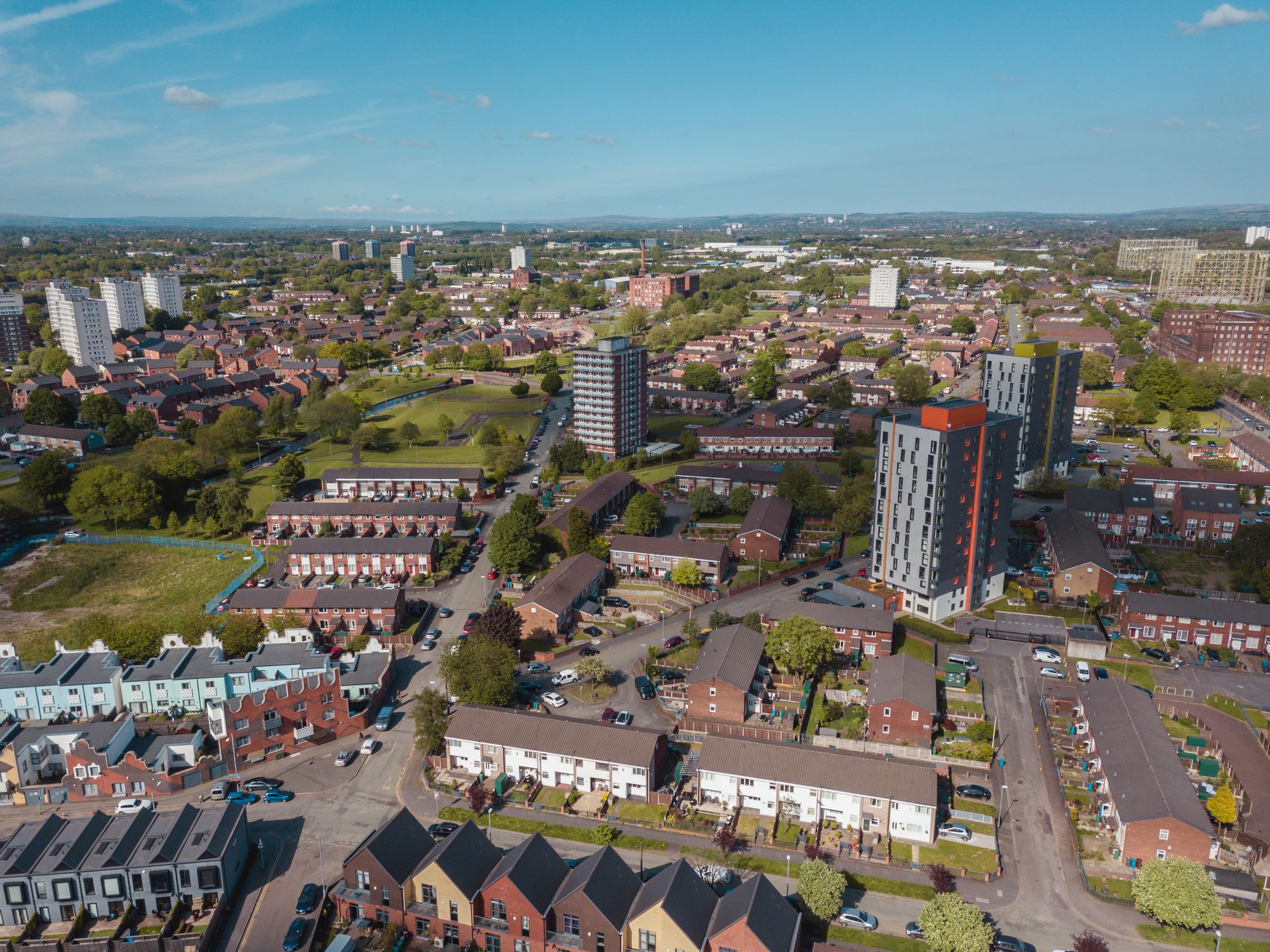
Key points:
■ Spatial strategies for inclusive growth can include changing priorities for infrastructure and investment as well as building local economies through fostering local enterprises and maximising benefits of local spend, and targeted social policies.
■ The policies announced by GMCA during 2019 demonstrate clear intent to take responsibility for spatial inequalities and put in place spatial strategies and delivery structures to reduce them.
■ Key developments are the revised GM Spatial Framework, the focus on place in the GM Industrial Strategy and the neighbourhood-based delivery structure for the GM Unified Public Services model.
■ Examples from other times and places suggest how there can be stronger alignment of plans for growth sectors and places, governance mechanisms to ensure a spatial focus across policy and a focus on the highest priority neighbourhoods, and more support for community economic development.
Inclusive growth and spatial inequalities
Internationally and in the UK, the inclusive growth agenda tends to have a strong focus on spatial inequalities, addressing concerns about places that have been ‘left behind’ by de-industrialisation and by the emergence of new economic geographies in which central cities have tended to be more advantaged than peripheral areas. The RSA Commission, for example, emphasised that inclusive growth was about enabling people and places to contribute to and benefit from economic success (see Box 1), “addressing inequalities in opportunities between different parts of the country and within economic geographies” (RSA Inclusive Growth Commission, p.6). In this sense, it presents a clear challenge to the economy orthodoxy of recent decades which has resisted intervention in the geography of markets and emphasised the benefits to all of agglomeration economies.
The proposals that arise from this new spatial emphasis tend to be of five different kinds, operating at different spatial scales. One is the establishment of structures and funds that give places (usually at the regional or sub-regional level) responsibilities and powers to determine and deliver tailored local economic plans – local industrial strategies in England and regional economic partnerships in Scotland. Another is the suggestion that these economic strategies should pay attention to spatial inequalities between localities within larger places.
As the independent Industrial Strategy Commission put it “an industrial strategy should not try to do everything everywhere, but it should seek to do something for everywhere”. The RSA Commission advocated “resourcing place regeneration as well as business investment” (p.10). Third, as discussed in Chapter 5, inclusive growth has an emphasis on capturing the greatest local benefit from economic activity, through procurement and commissioning. Applied to places, this often includes work to maximise local benefits of major housing or industrial developments, and/or focusing the activities of ‘anchor institutions’ on particular local areas rather than city or city region geographies. Fourth, there can be a neighbourhood or locality focus within economic development, with coordinated and sustained efforts in a place to support and network local firms and support local ownership of assets and organisation of services. Fifth, other policies and activities such as education and skills and health initiatives, may be targeted on specific places. As is the case at larger spatial scales, an inclusive growth approach should ‘join up’ economic and social strategies in places so that they are mutually reinforcing, although this is additionally challenging.
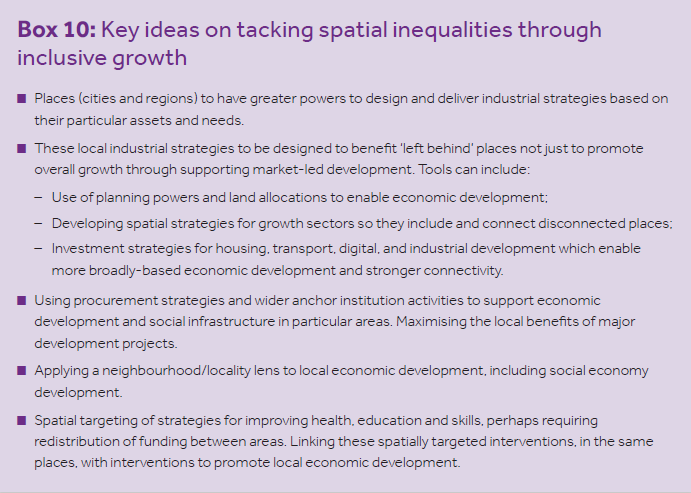
Box 10: Key ideas on tackling spatial inequalities through inclusive growth
Box 10: Key ideas on tackling spatial inequalities through inclusive growth
Policies on spatial inequalities in GM
How to approach the spatial (im)balance of the GM economy within the context of commitments to inclusive growth has been a contested issue within the GM ‘family’ of organisations in the decade since the MIER. While its underlying enquiries had a focus on spatial inequalities at the neighbourhood level, the MIER report downplayed the importance of place, emphasising that deprivation arises at individual not neighbourhood level and therefore gave weight to strategies to target individual educational attainment (including the early years), skills, and ‘worklessness’. The MIER explicitly rejected any redistribution of economic activity and emphasised the importance of growing the GM economy overall and encouraging concentration of activities in the regional centre to capture agglomeration benefits. This approach underpinned GM’s economic strategy for the next decade. By summer 2016, when the Brexit referendum highlighted widespread discontent in ‘left behind’ places, it was already attracting increasingly vocal critique from politicians in less economically successful areas of the conurbation. These critiques were also raised in the consultation over the initial (2016) draft of the GMSF, which largely persisted with the ‘regional centre and growth hub’ strategy.
In 2019, the publication of the revised GMSF signalled the adoption of a significantly different approach. In his foreword to the document, the Mayor describes its purposes as spreading prosperity more widely, especially to the North of GM. The term ‘inclusive growth’, referring to spatially more even growth, features very prominently throughout the strategy. Indeed it is stated that “the central theme of the spatial strategy for Greater Manchester is to deliver inclusive growth across the city region, with everyone sharing in the benefits of rising prosperity” (p. 41). Targets include both the GMS priority “a thriving and productive economy in all parts of GM” and a target to “reduce inequalities and improve prosperity”. There are specific goals to reduce the number of wards in most deprived 10% nationally of the IMD, and to strengthen the competitiveness of the North of GM. While the earlier emphasis on making the most of the key locations and assets best-placed to support economic growth is retained, the revised plan also prioritises “providing high quality investment opportunities across Greater Manchester that help to address disparities”.
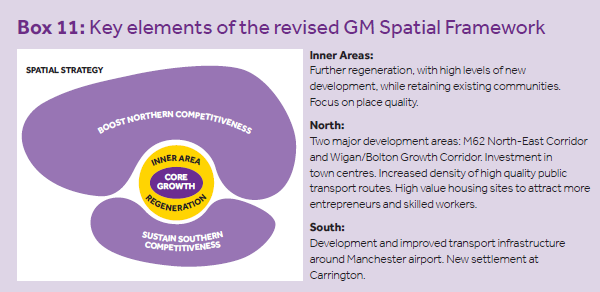
Box 11: Key elements of the revised GM Spatial Framework. Source: GMCA (2019) Greater Manchester Spatial Framework revised draft.
Box 11: Key elements of the revised GM Spatial Framework. Source: GMCA (2019) Greater Manchester Spatial Framework revised draft.
IGAU’s analysis of this plan found a relatively good fit between areas of proposed new investment and areas of severe income deprivation. Of the 159 neighbourhoods (defined by LSOAs) that can be categorised as ‘severely income deprived’, 97 (61%) are within a three-mile radius of at least one of the proposed employment allocations identified. Of these, 43 are places that have been on a downward trajectory (getting worse in terms of income deprivation) since 2001. Of course, whether the sites actually bring benefits to local residents depends upon the volume and quality of the employment opportunities, the extent to which they are able to acquire relevant skills, accessible and affordable transport provision and many of the other issues raised elsewhere in this report. Plans for inner regeneration areas will need to include sufficient affordable housing, recognising the notion of the rights of lower income households to access the city and not be driven to the periphery and be judged not just in terms of reductions in deprivation rates, but absolute numbers of poorer households and benefits to those households. As we reported in Chapter 2, improvements in rates can be the result of gentrifying processes which may not impact on those at the bottom of the income distribution. Our consultation exercise identified a need for specific inclusive growth plans to be built into major regeneration schemes (both those already underway in particular local authority areas and those which are part of longer term plans) and for there to be some oversight of delivery of these plans, since the experience of past developments has often been that they have not yielded the benefits for existing residents that might be hoped for or expected.
In addition to the core proposals over the GMSF, plans also now include the Mayor’s Town Centres Challenge, incorporating a Mayoral Development Corporation (MDC) in Stockport, covering 130 acres of brownfield land and plans for a new urban village; and proposals for six other town centre schemes (Farnworth, Leigh, Prestwich, Stalybridge, Swinton, and Stretford), which have no core finance from GM but could include use of Compulsory Purchase Orders (CPOs) and Mayoral grants to kick-start planned developments.
GM’s Local Industrial Strategy also signals a less centric approach to the GM economy, founded partly on an analysis of GM’s economic complexity in the GMIPR. Among the GMLIS’ strategic priorities are to: ‘ensure a thriving and productive economy in all parts of GM, by maximising national and international assets, city and town centres, strategic employment locations and neighbourhoods’ (emphasis added), and the implementation plan emphasises the intention to “strengthen economic areas across the city region based on their unique opportunities and challenges, building on the diversity of its people and places”. As a starting point, each GM LA is setting out how the GMLIS links with the opportunities and barriers in their own locality, and plans will be developed to coordinate GM and district level implementation. What will be critical in this process is the link between the sectoral growth strategies in the GMLIS – health innovation, advanced materials and manufacturing and digital, creative and media – and the spatial elements, so that these growth sectors bring maximum benefits to less advantaged localities and neighbourhoods. This will need to involve multi-faceted (and joined up) approaches including development of local specialist clusters, spatial targeting in the development of skills pipelines for growing industries, and local supply chain development through business support, grants and procurement policies. Some of these opportunities are already signalled in the implementation plan, for example the development of creative clusters in Oldham and Ramsbottom and a digital cluster around Ashton Old Baths in Tameside. The GMLIS commits GM to consider creating a fund to grow local independent production companies as well as attracting others to relocate, with enhanced skills support to enable residents to access these opportunities. The next year will be important in the development of this approach.
The Social Enterprise strategy announced in the GMLIS is yet to emerge and at the time of writing, the recommendations of the Co-operative Commission are not yet known, so it is not yet clear whether there will be a GM-wide approach to developing the local social economy as part of strategies to reduce spatial inequalities and develop thriving and productive economies across GM. In a number of places in GM, work of this kind takes different forms. Salford is one of Social Enterprise UK’s Social Enterprise Cities. Activities coordinated by Salford Community and Voluntary Services (CVS) have included working with residents to identify how social enterprises could tackle local challenges, and establishing a knowledge bank/exchange. Wigan Council established a £10m Community Investment Fund to support community groups and projects working towards improving outcomes for local residents – ranging from small grants to community projects to social enterprise start-ups and a community cooperative. In Rochdale, Rochdale Stronger Together (a collaboration of local institutions) is working to support and promote co-operatives, social enterprises and other community businesses to become well-established local suppliers of goods and services. The Rochdale Social Enterprise and Co-operative Forum offers support and training to new co-ops and social enterprises.
In relation to all of these issues (major developments, development of local economies, links to growth sectors and development of the social economy in places), the GM model of unified public services, with its focus on integrated working in neighbourhood teams, offers a major opportunity. It is significant that the industrial strategy implementation plan under the theme of ‘place’ also has a strategic priority to “continue reforming public services to ensure local public services are focused on improving outcomes and reducing inequalities”, signalling the importance of social policy to economic performance. But the spatial focus and organisation also offers the potential both for an increased focus on community economic development and its linkage to joined-up services, and for integrating neighbourhood plans within plans for growth sectors and major developments. A forthcoming IGAU working paper suggests how GM can build on its analysis of economic complexity to take a more holistic view of the how the economic, social, cultural and natural assets of places combine to contribute to economic development.
Overall, the developments announced in 2019 represent clear intent at the GM level to take responsibility for spatial inequalities and put in place spatial strategies and delivery structures to reduce them. This fills a gap in English policy making, since central government withdrew from responsibility for spatial inequalities in 2010 and removed requirements and resources for LA level partnerships to do the same. There is potential to go further in building local inclusive economy plans and linking these to emerging neighbourhood-focused public service structures.
Learning from other places: see case studies 13,14,15.
8. Addressing disparities between groups
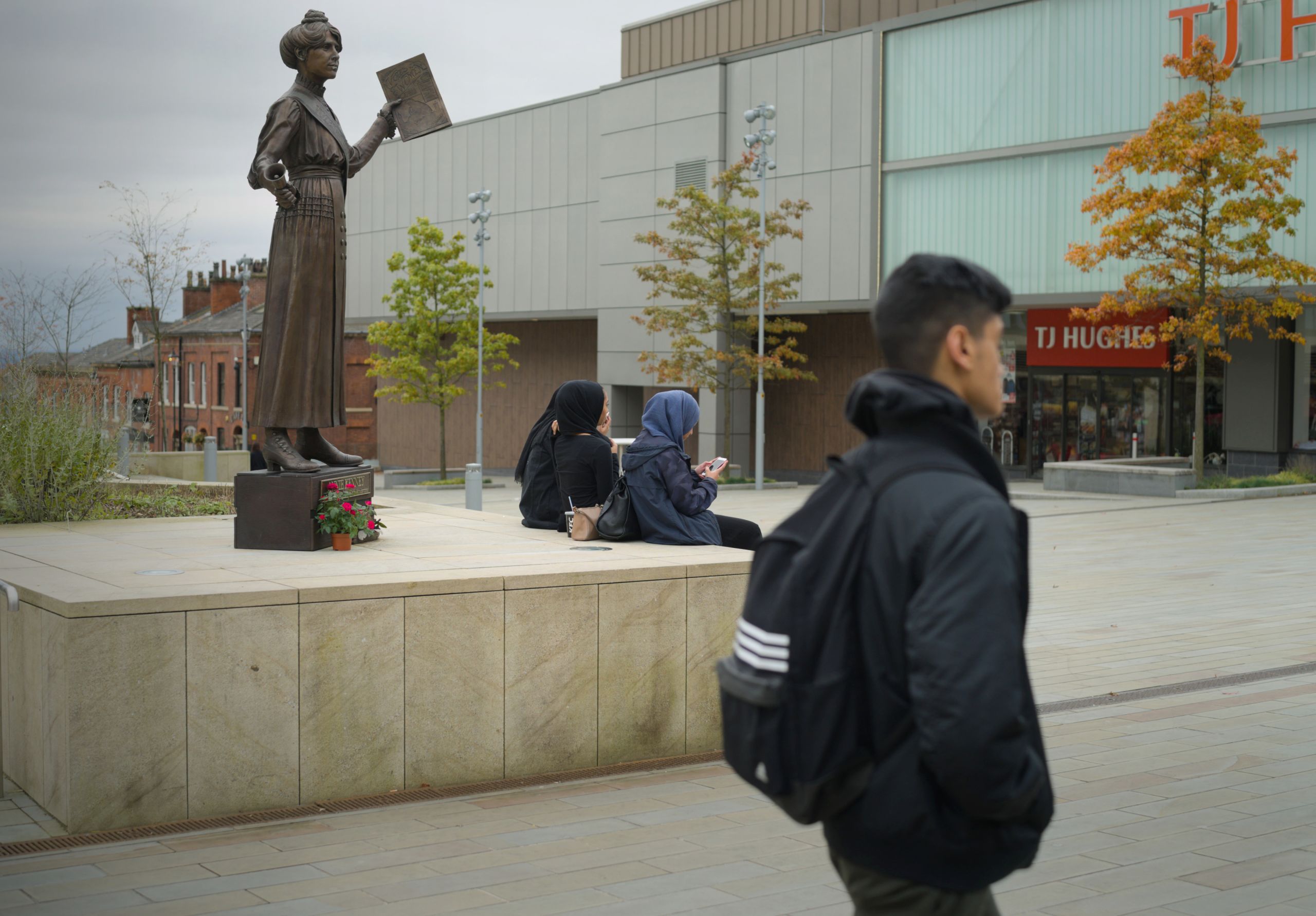
Key points:
■ Action on inclusive growth must be informed by an understanding of who is not currently included and why, with tailored strategies to tackle between-group inequalities.
■ In GM, some progress has been made to recognise disparities between groups protected under the Equality Act 2010, and represent their needs in new GM-level panels.
■ However, measuring, tackling and monitoring equalities between groups has not being systematically built into inclusive growth policies.
■ Examples from other places suggest that more could be done to systematically assess the impact of policies on different groups and to develop tailored programmes as part of inclusive growth policies to reduce inequalities.
Addressing economic inequalities between social groups
Although much of the inclusive growth literature focuses on economic inequalities (i.e., between people in the distribution of educational attainments, jobs, wages, earnings, incomes, opportunities), inequalities between social groups in their access to and benefits from the economy are also a core part of the agenda. Inequalities between groups have been emphasised by both the RSA Commission, who noted that “the economy is experienced differently by different social or demographic groups” and the OECD framework for inclusive growth that clearly connects gender equality, diversity and non-discrimination to inclusive growth. Social and spatial inequalities are inter-related, since disadvantaged groups are more likely to live in disadvantaged areas, and this may compound their existing disadvantage.
Action on inclusive growth must be informed by an understanding of who is not currently included and why, with tailored strategies to remedy between-group inequalities and build equality in. Such strategies might be in relation to individuals, improving access and reducing barriers to labour market participation, and also in relation to institutions, for example improving support for women-led or minority-led businesses. These need to be underpinned by representative and consultative structures which allow multiple voices to be heard and address historical power imbalances in decision-making. This chapter focuses principally on two large axes of economic inequality: gender and ethnicity. Disparities can of course be traced on multiple other axes, typically according to the ‘protected characteristics’ in the 2010 Equality Act.

Box 12 Key ideas on reducing between-group disparities
Box 12 Key ideas on reducing between-group disparities
Addressing disparities in Greater Manchester
The GMS states under Priority 3 that, “Age, gender, sexual orientation, race, disability or socio-economic background should be no barrier to success in Greater Manchester” (p. 29). Equalities issues are prioritised in GM governance, with a portfolio in the Mayor’s Cabinet (originally ‘Fairness, Equality and Cohesion’, currently ‘Age-Friendly Greater Manchester and Equalities’). The principal developments in this space since 2016 have related to BME groups and to women, but they are limited.
In respect of ethnic inequalities, the need for attention to differences in economic outcomes has been highlighted through the work of the GM Cohesion Commission, established by the Mayor following the Manchester Arena attack. One of the Commission’s four objectives was to identify the “broader determinants of social exclusion” and in its report, the disparities between ethnic groups in economic opportunities and outcomes were identified as “likely to have a negative impact on social cohesion and may have an impact on risk of radicalisation” (p.6). The report advised that GMCA should accept all recommendations of IGAU’s paper on ethnic inequalities in the labour market. The recommendations include establishing regular monitoring (a local Race Disparity Audit and/or ethnic breakdowns of the key indicators in the GM outcomes framework); creating employment targets; making fair recruitment practices part of any new ‘good employment standards’ for GM and reviewing and dismantling barriers to the take up of apprenticeships by BME groups. The report also made recommendations for other GM public sector institutions, for the LEP and business representatives to develop strategies for increasing BME employment in relation to key growth sectors and strategies for meeting skills shortages.
Some of the Cohesion Commission’s recommendations have been taken forward but to date only in a limited way. The GM Good Employment Charter asks employers to sign up to “transparent, fair and inclusive practices” in recruitment and progression, and “fair and inclusive workplaces”. The GM Outcomes Framework includes disaggregated data for ethnic minorities for employment rates, although not in other areas. There has also been some work to recognise and measure the diversity of apprenticeships in GM, which was formalised in Manchester’s participation in the ‘5 Cities Project’. So far the outcomes have included: the GMCA report ‘Apprenticeships and diversity in context’ revealing the ethnicity gap in GM, the GMCA guidance for employers to increase apprentice diversity, and a target for reducing the ethnicity gap. However, there is no mention of ethnic inequalities made in the GMLIS or its implementation plan, and a very brief mention in the GMIPR.
At the time of writing there are plans to develop better links between BME communities and the work of the Combined Authority. The Mayor has requested that a series of roundtables are convened to explore the option of establishing a GM ‘faith and race equality panel’, and if so, what it should do, and who should be involved. This would bring faith and race representation in line with some other groups protected in the Equality Act, with representative panels; the Mayor established a Lesbian, Gay, Bisexual and Transgender (LGBT) panel in 2018, and a Disabled People’s Panel in 2019. It is unclear how the Panels formally relate to other existing structures. Gender equality issues have had a higher recent profile, perhaps partly because of active campaigning around the time of the mayoral election which elicited gender equality pledges from all mayoral candidates.
This followed longer-standing concerns about a lack of diversity at the GM decision-making table, and after the establishment of DivaManc that brought women’s voices into the devolution discussion. In 2018, the Mayor announced a gender-balanced Combined Authority, although this is limited in practice since the assistant portfolio leads (who make the authority balanced and are largely women) are not allowed to vote in meetings. As of March 2019, civil society actors and activities are being brought together in a ‘Women’s Voice group’, whose remit is ‘to check and challenge policymaking in Greater Manchester’. In the GM Outcomes Framework some attention is given to gendered inequalities, with disaggregated data by sex available on indicators (in priorities 1, 2 and 9) but comparison of disparities between the groups is not available.
These developments suggest that more attention to women’s economic position (for example in low paid and part time jobs) might be on the horizon. The GM Growth Hub has also recognised the need for dedicated business support for female-led businesses. The Hub has started analysing the gendered take-up of their current programmes and have announced plans to develop ‘female-focused programmes’ to encourage more women to start and scale up their own businesses. Details of these programmes are expected shortly.
In relation to gender, ethnicity or other protected characteristics, we find little evidence of impact assessment in the development of GMCA strategies. There has been one published equality impact assessment screening report in January 2019 for the GMSF, which found that “the draft GMSF is unlikely to have negative effects on protected characteristics or persons identified under the Equality Act 2010 and as a result a full EqIA will not be required at this stage”.
Equality impact assessments (EqIAs) can be carried out by public authorities prior to implementing a policy, in order to determine its potential impact on equality. Government bodies are not required by law to conduct such assessments, but they are required to meet their Public Sector Equality Duty, and the EqIA can be a useful tool to ensure they are complying with that duty. However, ensuring robust scrutiny of spending decisions and effective impact assessing requires capacity and resource, and while the creation of combined authorities has created another tier of public sector responsibility in which equalities must be considered, devolution settlements between central government and CAs have not devolved funds for equalities work.
Overall, tackling economic disparities between groups is an area of inclusive growth that is developing but lacking resource and direction in GM. There has been some progress in representation of excluded groups through the LGBT panel, disabled people’s panel, women’s voice group and now potentially a race and faith panel; however, their remit within existing structures could be clearer, as well as their involvement in tailoring policies. There has been less progress in the development of specific policies and their integration within economic strategies and broader inclusive growth policies. Measurement of inequalities and monitoring impact is also under-developed at this stage.
Learning from other places: see case studies 16,17,18,19.
9. Conclusions and recommendations
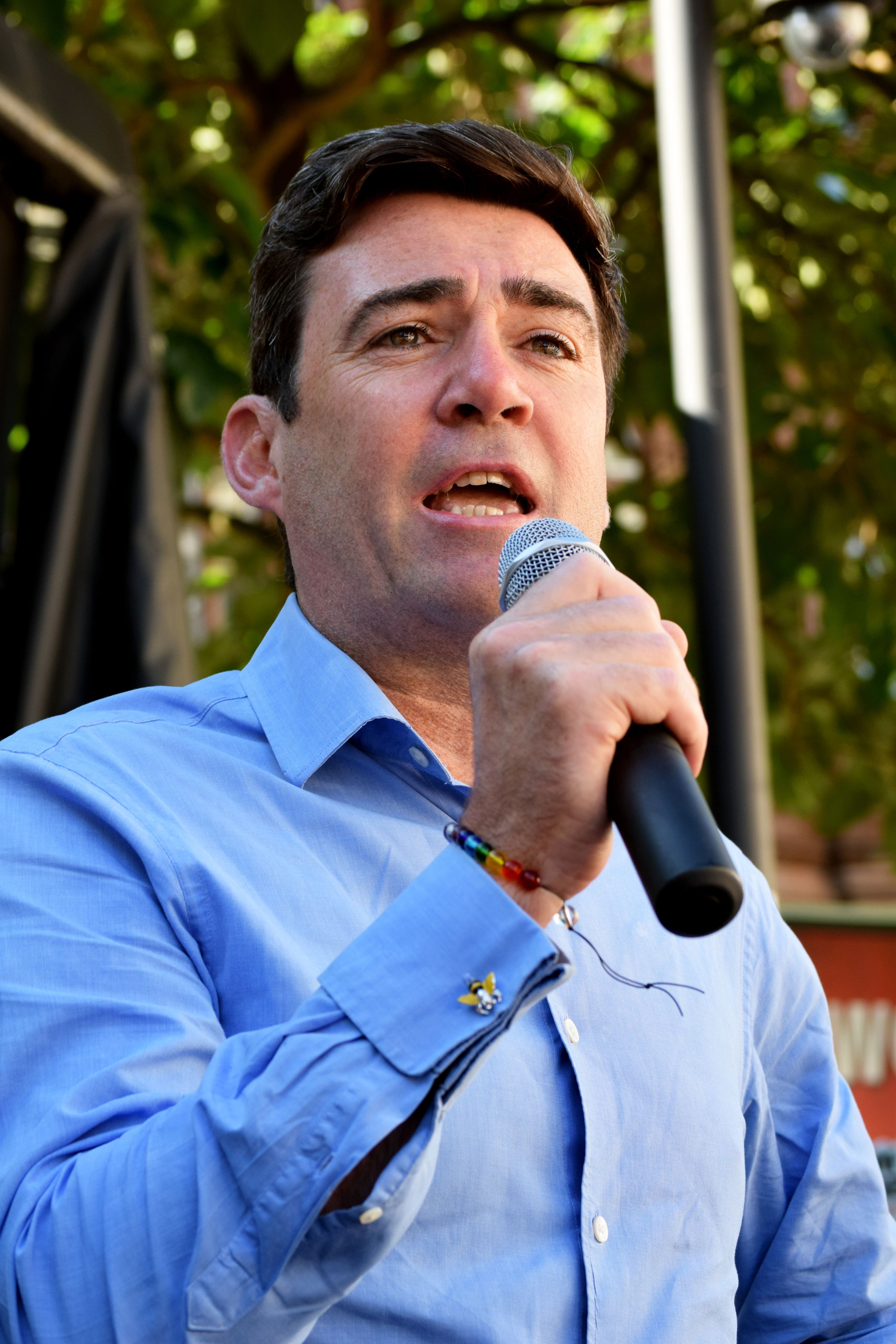
Conclusions
This report has assessed policy progress on inclusive growth in Greater Manchester since 2016. Creating more widely shared prosperity in GM is not just a local issue. It will need central government action and investment, both a new commitment to rebalancing the economy regionally and dealing with deficits in infrastructure and social investment, and a new approach to the economy which prioritises a fairer distribution of opportunity and reward alongside greater economic resilience and environmental sustainability.
However there is potential for action at the city/city-region level. International examples suggest that it is at this level, with visible and accountable leadership, that economic and social policies can be effectively integrated in bespoke ways which address the particular needs/values/identities of particular places. In the UK, devolution is creating opportunities for more systemic action on inclusive growth, albeit the extent of local power is still limited by international comparison, new approaches have had to be crafted in austerity conditions, and there has been there has been limited devolution of resources to programme delivery, research and evaluation.
GM has had long standing strong political commitments to inclusive growth but until relatively recently, much of its work focused on improvements in public services. Since 2017 this work has accelerated, with the adoption new model of integration at the neighbourhood level. With increasing devolution and the election of the Mayor, there have been many new programmes and initiatives, around health, skills, and work, as well as new initiatives on transport and housing. Perhaps more notably from the perspective of inclusive growth, there have also been some changes in policy towards the economy. The revised spatial framework signals a much broader approach to the GM economy, with development plans for town centres and northern industrial areas, as well as continuing to develop the regional centre and capitalise on assets such as the Airport. The new industrial strategy, while promoting GM’s ‘frontier sectors’ and distinctive strengths, also acknowledges the important role of the ‘foundational’ economy and the need to focus on productivity and the quality of work in the large low paying sectors that make up a large proportion of GM employment. It commits to a social enterprise strategy. A Co-operative Commission has been established and a good employment charter developed. There have also been moves towards a more inclusive approach to governance at GM level, which should provide a foundation for decision-making that takes into account the interests of excluded groups.
These developments represent substantial progress. Making the most of them will demand continued effort and capacity over the next few years, including for delivery, as these early initiatives need to be turned into sustained action. There will be an increasing need for evaluation, research and intelligence to support policy development. There will also be new opportunities which will need to be approached with an inclusive growth lens including: bus franchising; the implementation of GM’s Unified Public Services Model; and the partnership announced in the GMLIS with DfE and DWP to start developing a more coordinated approach to post-16 education, work and skills.
In our view, what we have not yet seen in GM is the bringing together of these emerging policies in a clear vision of inclusive growth and an integrated approach which can underpin policy-making, resourcing and delivery and set a direction for the longer term. Inclusive growth still means different things to different people in GM, is used not at all or is used in different ways in policy documents, and does not reach fully or consistently through implementation plans. It is more prominent in spatial plans than it is in GM’s economic narrative. This is in contrast to some other parts of the UK where inclusive growth is being adopted as the central objective of economic plans and/or it is becoming embedded into policy-making and investment decisions through the use of inclusive growth metrics, appraisal and decision tools, and/or funds are being made available for pilots and experiments to guide the way to longer term change.
Moreover, inclusive growth in GM is currently probably best seen as a set of policy efforts to solve policy problems, such as low productivity, poor skills, disconnection from employment opportunities, low pay and lack of progression. It is not a long term vision, shared by the citizens of GM, which sets out goals, values and principles about the kind of growth GM wants, how it will be achieved, and how it will serve wider social and environmental objectives and ensure a successful inclusive transition into a low-carbon, high tech future.
GM is are now moving into a new policy period with a new 4-year Mayoral term, and a refreshed GM strategy, and potentially a renewed commitment to devolution from central government. At this juncture, GM has an opportunity not only to consolidate and extend its work, embedding inclusive growth more thoroughly in the years immediately ahead, but to set out a more ambitious vision of how a city-region can lead inclusive growth into the future.
Full report PDF available here
Recommendations
1. In the next Mayoral Term (2020 -2024) the Mayor of Greater Manchester should signal a commitment to inclusive growth as the central motif of his/her Mayoral term. His/her central objective should be to set GM on a long term path towards a fairer and more sustainable economy and society.
To support this:
1.1. The political leaders of GM should adopt a clear statement of what they mean by inclusive growth and the ways in which it will make a difference to GM citizens. This should be the centrepiece of the new GM strategy (GMS) and therefore jointly agreed by the Local Enterprise Partnership, Growth Board, Reform Board, and Health and Social Care Partnership. In so doing they will integrate economic and social policy in single guiding mission, and ensure implementation and monitoring through the established GMS processes and structures.
1.2. Stronger mechanisms should be established to ensure that inclusive growth outcomes are considered in all major policy decisions. These should include:
- Strengthening the GM outcomes framework with a more extensive distributional analysis, so that trends affecting different ethnic and social groups, and different places, are more visible.
- Embedding an inclusive growth project appraisal or diagnostic tool as a standard element of policy development.
- Sharing emerging examples of good practice in this respect within GM and developing common approaches at sub-GM level.
- Including ‘contribution to promoting inclusive growth in GM’ as a required consideration on all GMCA reports for decision, and adding inclusive growth to the remit of each of the scrutiny committees and panels.
- Routinely conducting equalities impact assessments for major decisions. This may require extra capacity either from central government, GMCA or the involvement of external organisations.
- Strengthening representation and diversity in policy making process, for example: initiating new leadership programmes for women and BME groups as part of the work of GM Leaders; delegating leadership on specific issues (such as gender equality) to representative groups.
1.3. GM should ensure that it has the dedicated support for research, analysis and policy development that development of a long term inclusive growth agenda requires. This function has been provided to some extent by the independent IGAU (funded by the Joseph Rowntree Foundation and University of Manchester) but this programme is coming to an end in December 2020. GM should set up a successor organisation to provide independent analysis and policy expertise, support on metrics, appraisal and diagnostic tools, and lead on convening and supporting organisations across GM who are working on inclusive growth. Resources should be sought from business, universities, central government departments and agencies as well as GMCA, and the team should include staff (permanently or on secondment) with expertise in multiple different areas. The organisation should have an independent Chair and multi-stakeholder board, as well as clear links to grass-roots organisations (through existing structures or an inclusive growth forum). It could have leaders/champions for different issues drawn from different sectors and geographies).
1.4. In the context of the government’s recently announced devolution White Paper, GMCA should work with other Mayoral Combined Authorities, central government and the broader policy community to make clear the principal financial, policy and regulatory barriers to inclusive growth at subnational levels and how these can be addressed in future devolution settlements. This should include attention to the research and intelligence barriers to effective local action (including subnational data and research and intelligence capacity).
2. Between 2020 and 2024, The Mayor, Combined Authority and other GM leaders should take specific action to embed and develop inclusive growth strategies for the economy, places and people.
Developing an Inclusive Economy
2.1. Building on the examples in this report the Mayor and CA, with VCSE and business leaders, should set out to design and build a stronger and more integrated eco-system to support the development and continuation of inclusive economy activities (including business support, access to finance, start up support and incubation, and changes to commissioning processes to prioritise social value).
2.2. Meanwhile, the Mayor and CA should commit to:
- Supporting the implementation and development of the good employment charter including making resources available to work intensively with employers, especially those from under-represented sectors and types where it might be harder to take on charter commitments.
- Publishing their plan for the foundational economy by the end of 2020, including setting out how local procurement and delivery of social care can be reformed to provide good quality jobs.
- Providing support and resources to develop the work of the Co-operative Commission.
- Starting work on the development of mechanisms to protect quality of work and pay for workers in the platform/’gig’ economies.
- The Mayor should establish an Inclusive Growth Investment Fund in order to support innovative proposals led by business, voluntary, community and social enterprise actors and to support scaling up.
Reducing Spatial Inequalities and Building Confident Places Across GM
2.4. GMCA should develop inclusive economy plans for all major development sites identified in the GMSF and for the Town Centre Challenges. These should include issues such as job quality, skills pathways, transport needs and social value procurement and ensure that mechanisms are in place for delivery, monitoring and holding to account.
2.5. The Mayor should appoint a senior figure as a ‘Priority Neighbourhoods’ Champion who should have an overall objective to make sure all neighbourhoods of Greater Manchester benefit from the city’s economic, technological, environmental and social transformation, especially those which have previously been vulnerable to the forces of change. The Priority Neighbourhoods Champion should be supported through the GM structure and be responsible for:
- Identifying ‘priority neighbourhoods’.
- Developing an approach to monitoring neighbourhood outcomes. This should include actual reductions in poverty and commitments to the rights of existing communities, not just overall rates of deprivation.
- Ensuring that the work of other key groups (e.g. Education and Employability Board, Skills Advisory Panel, School Readiness Board) is appropriately targeted to priority neighbourhoods.
- Working with public sector reform teams to develop minimum standards for public services in places.
- Ensuring that there are strong and well-functioning neighbourhood teams in these neighbourhoods.
- Developing some “Total Place Plus” pilot projects which will build on the Unified Public Services Model to incorporate shared planning and delivery in public services with place-based social economy and employment initiatives.
Connecting People to Opportunities and Reducing Inequalities Between Social Groups
2.6. The Mayor and GMCA should establish strategic oversight of the GM education and training system as a whole, whether or not additional formal powers are devolved. i.e. they should establish improvement and coordination strategies covering workforce, resources, and priority issues and areas, as they have done with health and social care.
2.7. As part of the implementation of the GMLIS, and supported by the proposed investment pot for LIS priority sectors, GMCA should develop inclusive education and training plans for growth sectors. These should involve reviewing curriculum content; building clear curriculum pathways involving schools, colleges and universities; initiatives with schools and communities to build knowledge of labour market opportunities; promoting stronger employer investment in training and where this is less easy (eg in areas with high proportions of SMEs) supporting this through subsidies; and career advancement/skill escalator programmes for adult learners. These plans should be linked to priority neighbourhoods work as above.
2.8. GMCA should ensure that it strengthens the links between equality and diversity strategies and education/employment/skills strategies. For example, developing targeted employment and skills programmes as part of sector strategies, and in its work on progression in low pay sectors.
3. The Mayor should also take steps in the next mayoral term to set a more ambitious long term economic, social and environmental vision for GM. Following the examples in this report, he/she should commission deliberative work with residents in order to understand what they mean by ‘prosperity’, ‘inclusion’, ‘living standards’ and inclusive growth and use this as the basis for the 2028 GMS.
Full report PDF available here

